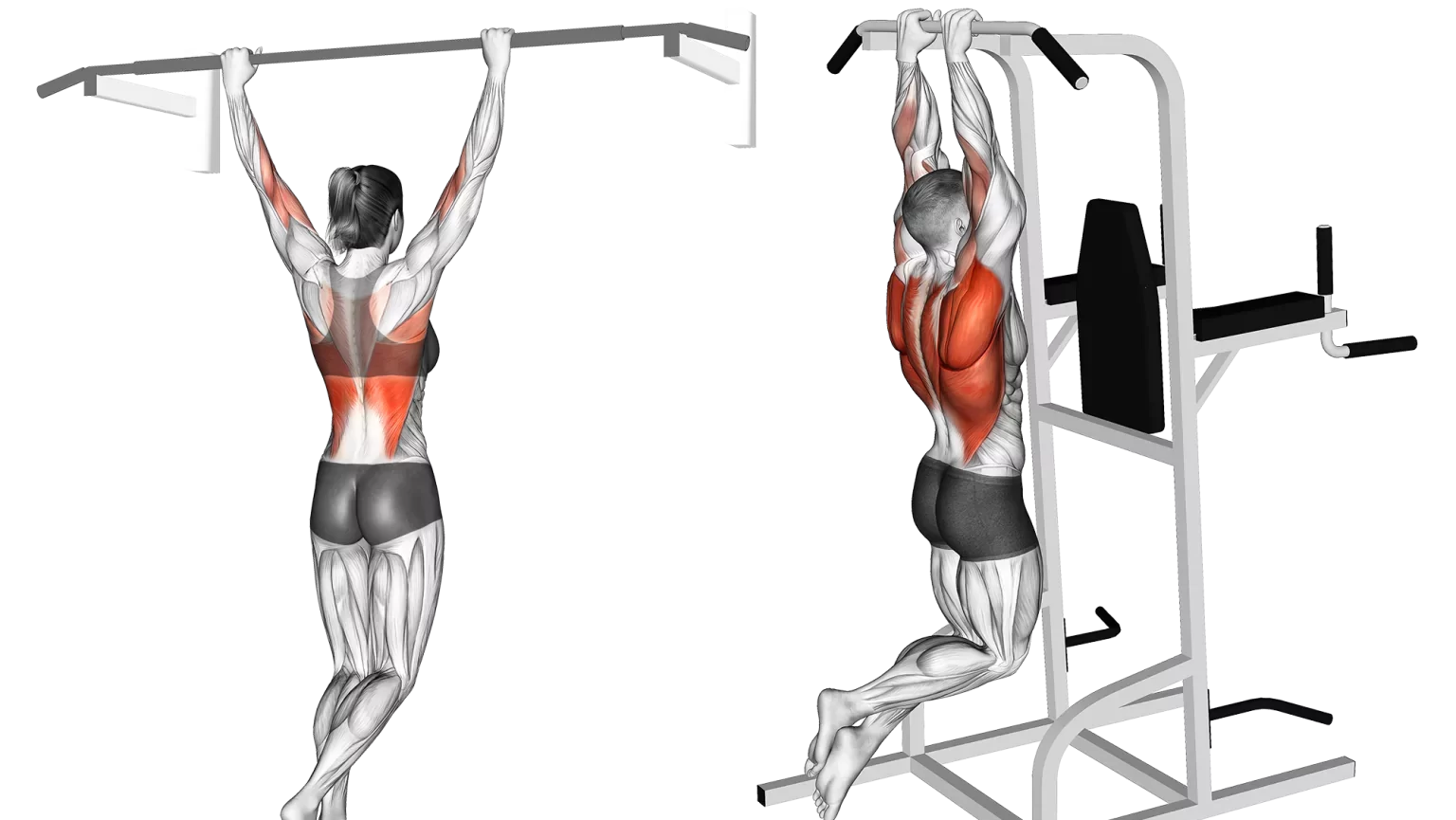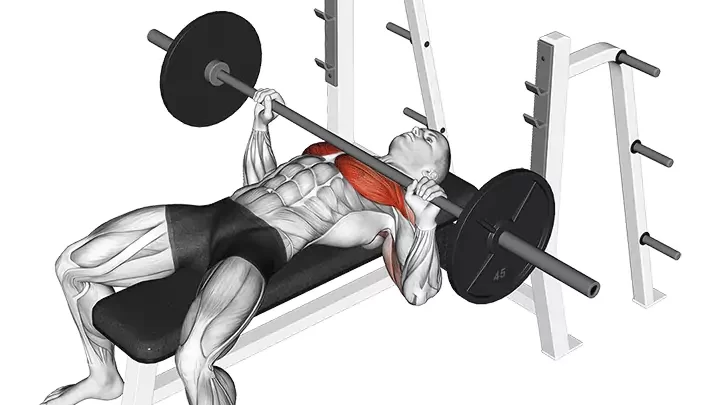Pull ups are a versatile and effective exercise that targets multiple muscle groups, including the back, biceps, shoulders, core, and chest. They are a great way to build strength, improve endurance, and enhance overall fitness. While pull ups can be challenging, the rewards are well worth the effort. To complement your pull up routine, consider incorporating Push Ups Exercises and Chest Exercises into your workout regimen.
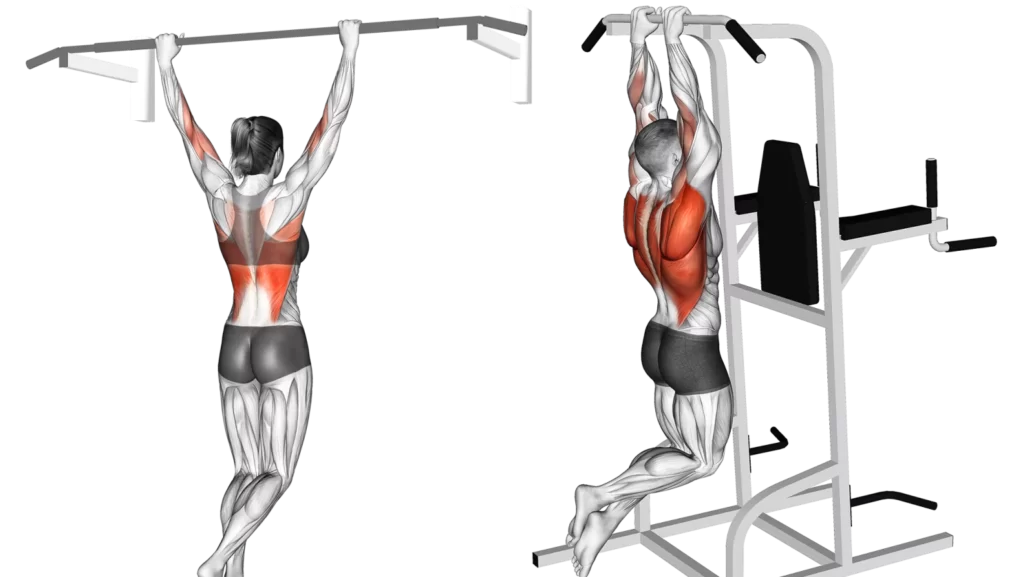
Pull Up
Pull-ups are a compound exercise that works multiple muscle groups in the upper body, including the back, biceps, shoulders, and core. They are a great way to build strength and endurance, and they can also help to improve posture and coordination.
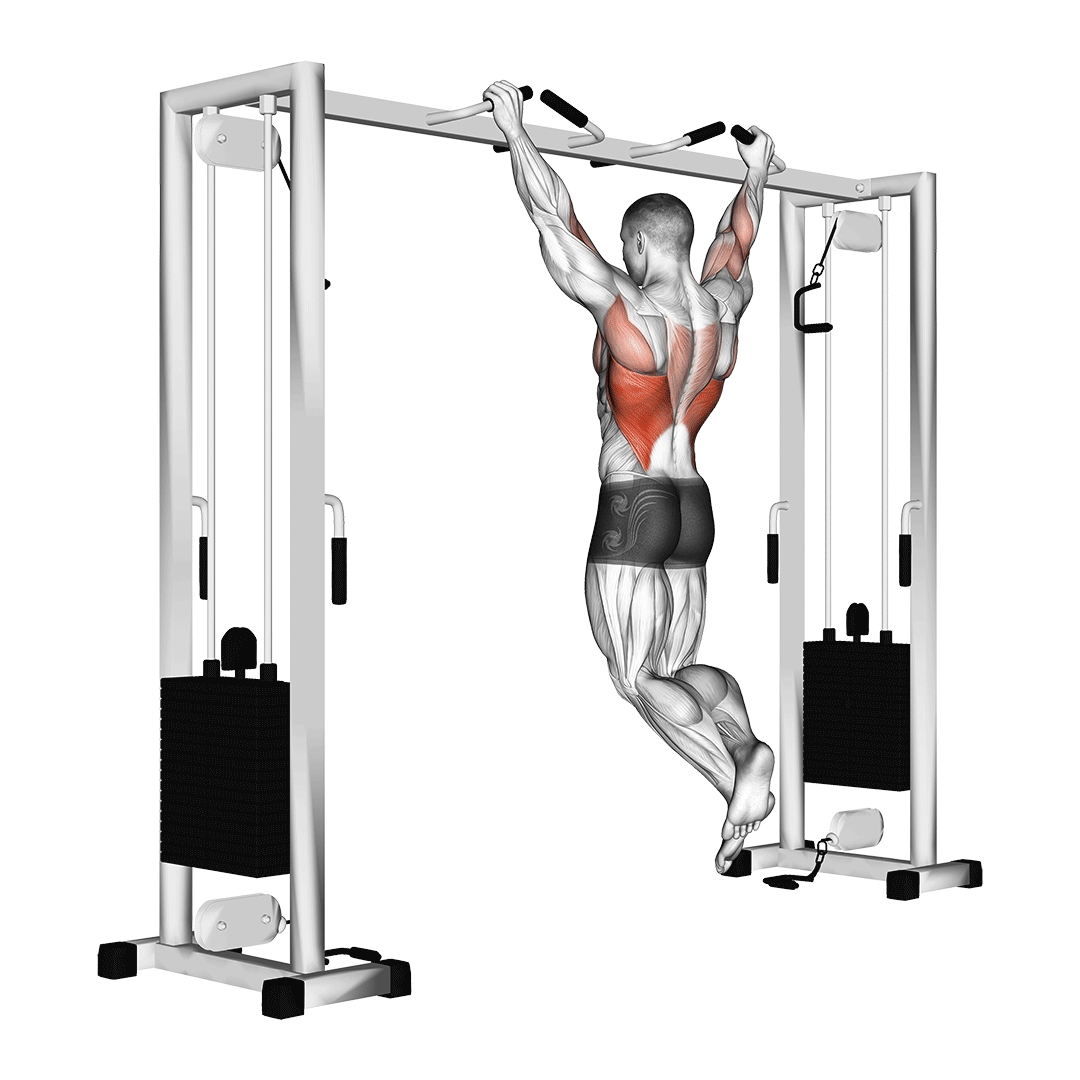
How to Do a Pull Up
- Grip the bar: Stand facing the bar with your feet shoulder-width apart. Reach up and grab the bar with an overhand grip, hands slightly wider than shoulder-width apart.
- Hang: Hang from the bar with your arms fully extended, keeping your body in a straight line from head to heels. Your core should be engaged throughout the entire movement.
- Pull yourself up: Squeeze your back muscles and pull yourself up until your chin is above the bar. Keep your elbows close to your body.
- Lower yourself down: Slowly lower yourself back down to the starting position, keeping your back straight and engaging your core muscles.
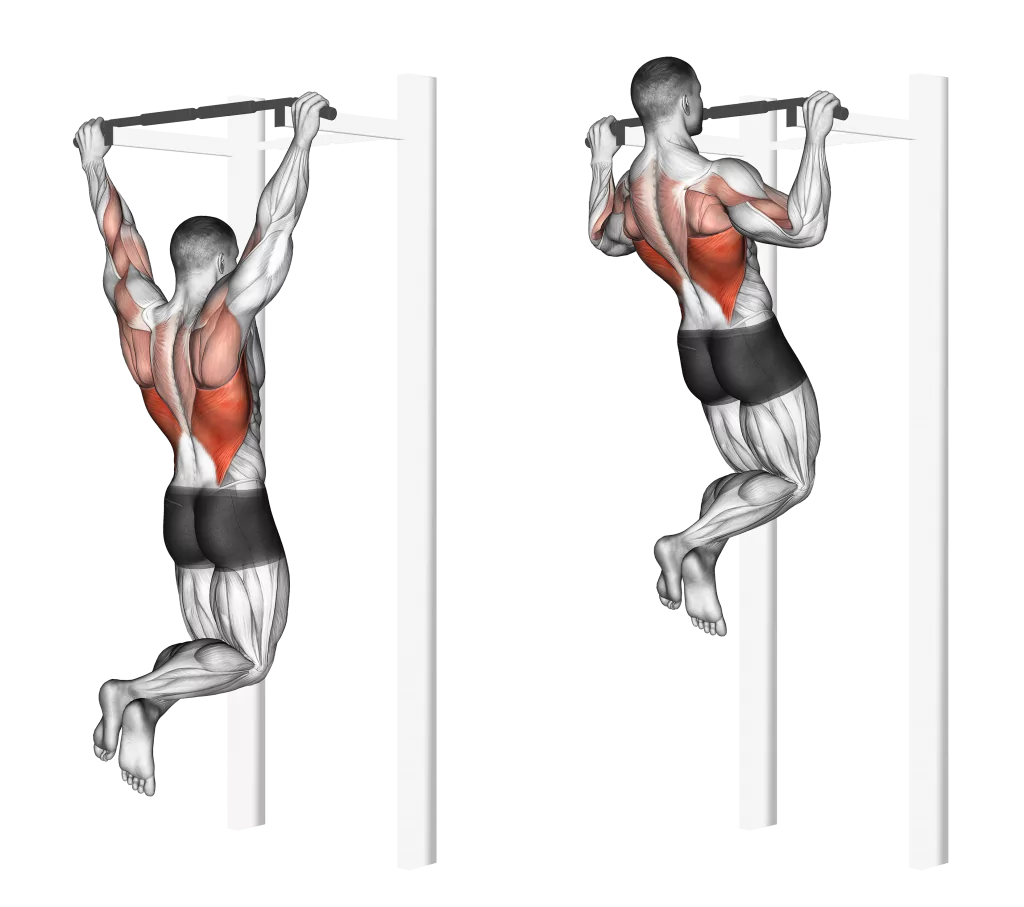
Muscles Worked by Pull Ups
- Latissimus dorsi (lats): The lats are the large, fan-shaped muscles that run down the sides of the back. They are the primary movers in a pull-up, and they help to pull your body up towards the bar.
- Biceps: The biceps are the muscles on the front of the upper arms. They help to bend your elbows, and they assist the lats in pulling you up.
- Shoulders: The shoulders are made up of several muscles, including the anterior deltoids (front of the shoulders), posterior deltoids (back of the shoulders), and middle deltoids (middle of the shoulders). These muscles help to stabilize the shoulder joint and control the movement of the arms during a pull-up.
- Core: The core muscles are the muscles in your abdomen, lower back, and hips. They help to stabilize your body during a pull-up, and they prevent your back from arching excessively.
Weighted Pull Ups
Weighted pull-ups are an advanced bodyweight exercise that targets your back muscles, including your latissimus dorsi (lats), trapezius, and rhomboids. They also work your biceps, forearms, and core.
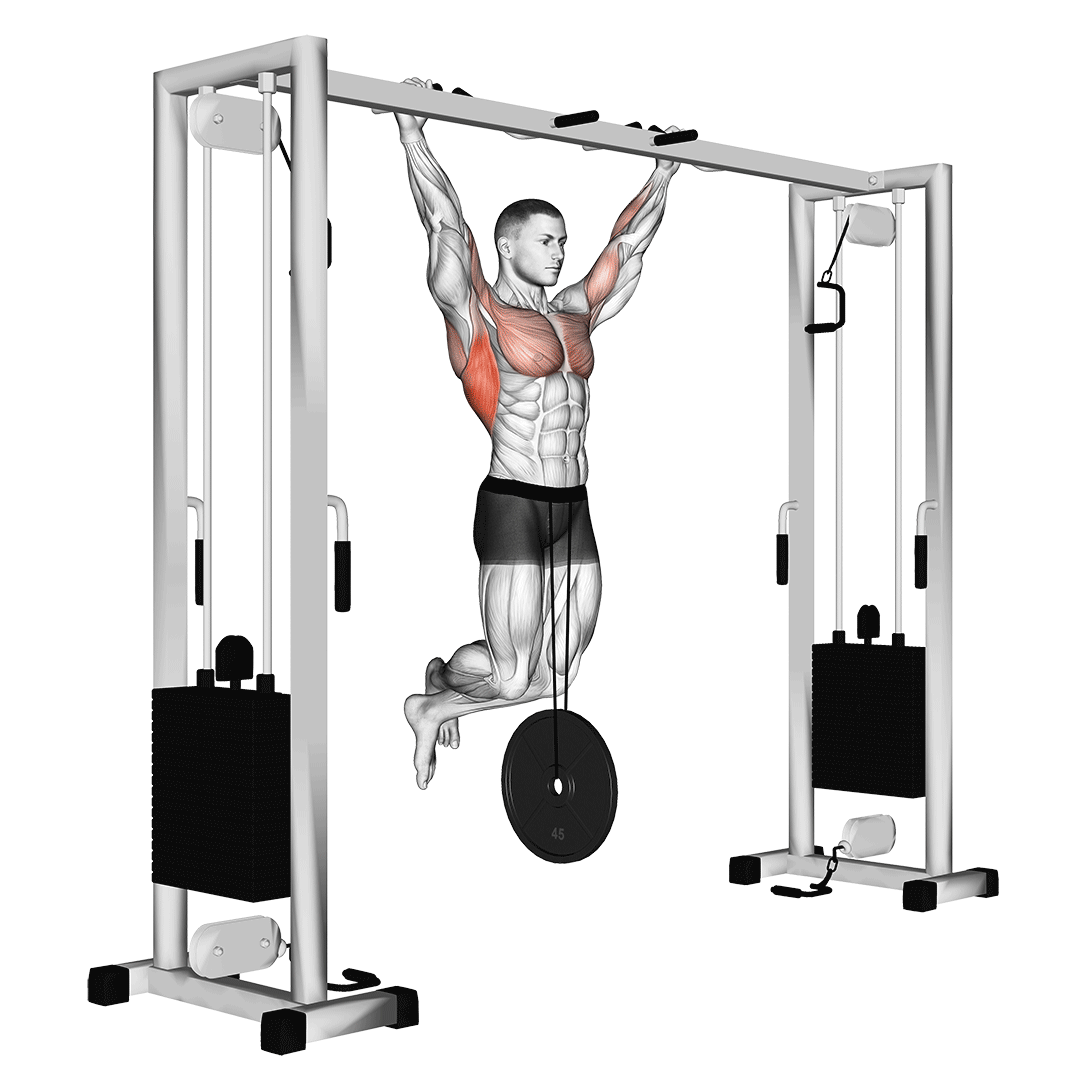
How to Do a Weighted Pull Ups
- Warm up. Before you start, warm up your shoulders, arms, and core with light cardio and dynamic stretches.
- Find a sturdy pull-up bar. The bar should be high enough that you can hang with your arms extended and your feet off the ground.
- Attach a weight belt. If you don’t have a weight belt, you can use a backpack or a chain to attach the weight to your waist.
- Hang from the bar with an overhand grip. Your hands should be shoulder-width apart.
- Engage your core. Pull your belly button in towards your spine.
- Pull yourself up until your chin is over the bar. Squeeze your lats and upper back at the top of the movement.
- Slowly lower yourself back down until your arms are fully extended. Keep your core engaged throughout the entire movement.
- Repeat for the desired number of repetitions.
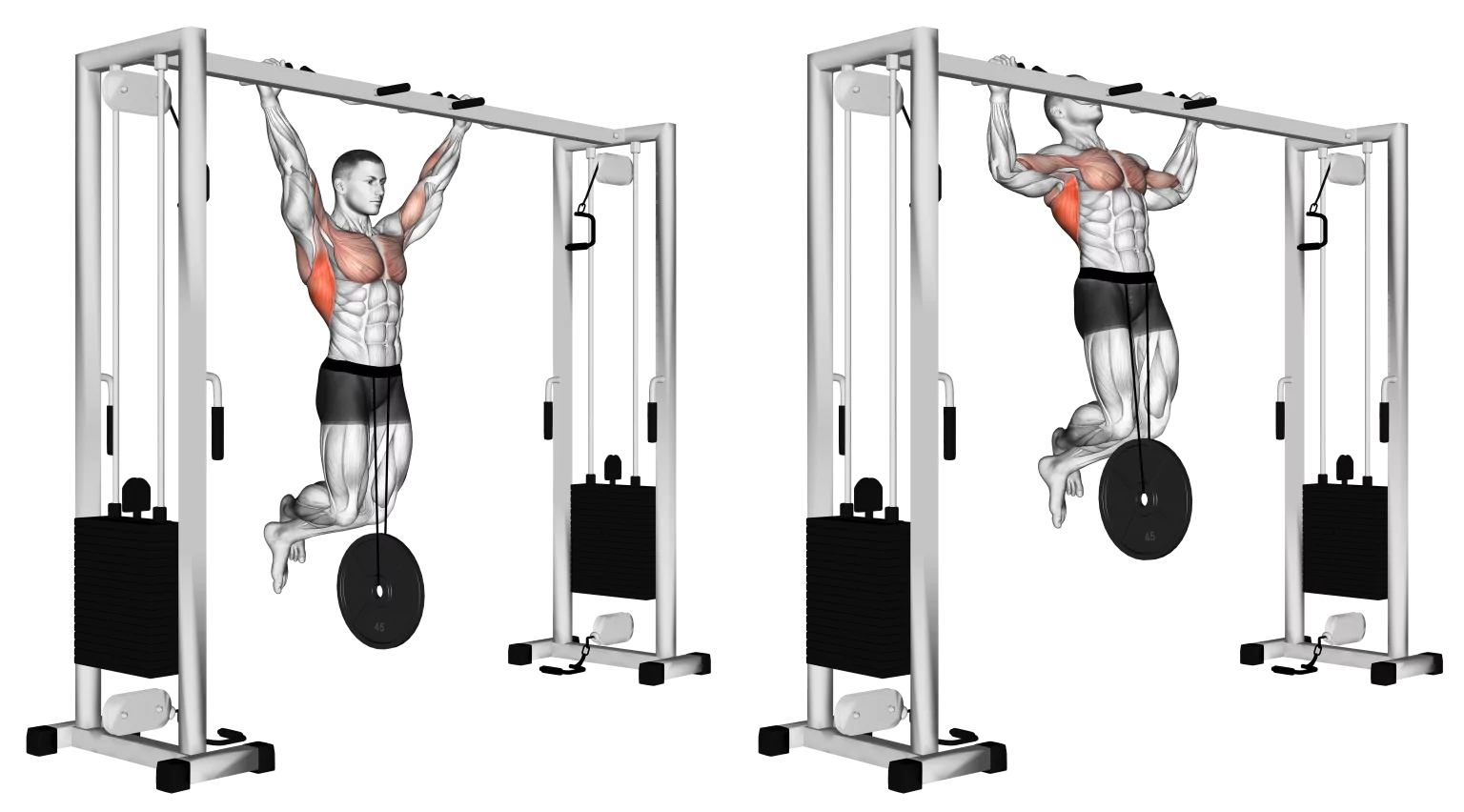
Muscles Worked by Weighted Pull Ups
- Latissimus dorsi (lats): The lats are the large, fan-shaped muscles that run along the sides of your back. They are responsible for pulling your arms down towards your body.
- Forearms: The forearms are responsible for gripping the pull-up bar. They are also worked isometrically during the entire movement.
- Biceps: The biceps are the large muscles that flex your elbows. They assist in the pull-up movement by helping to pull your body up towards the bar.
- Core: The core muscles, including your abdominals, obliques, and lower back muscles, are engaged throughout the entire pull-up movement to stabilize your body and prevent injury.
- Rhomboids: The rhomboids are a pair of muscles that lie deep in your back, between your shoulder blades. They are responsible for pulling your shoulder blades together.
- Trapezius: The trapezius is a large muscle that runs from your neck to your shoulders. It is responsible for raising your shoulders, shrugging, and extending your head.
Chin Ups
Performing chin-ups effectively involves proper form and engaging the right muscle groups. Here’s a step-by-step guide on how to do chin-ups and the muscles involved.
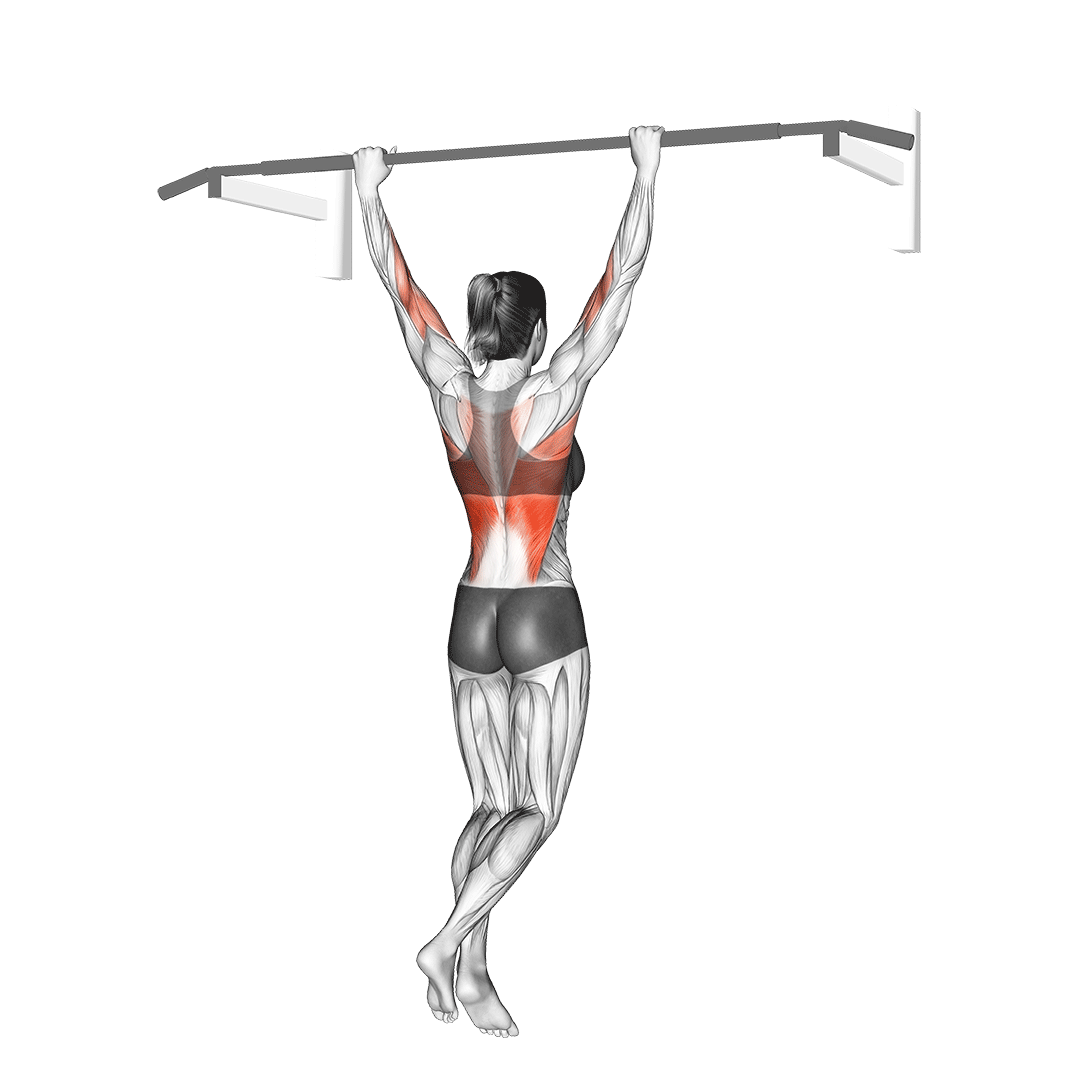
How to Do Chin Ups
- Warm-up: Start with a light cardio activity like jogging in place or jumping jacks to elevate your heart rate and warm up your muscles. Dynamic stretches like arm circles and shoulder rolls can further prepare your body for the exercise.
- Grip the Pull-Up Bar: Hang from a sturdy pull-up bar with your hands shoulder-width apart and palms facing towards you. This is known as a supinated grip, and it primarily engages your biceps and back muscles.
- Engage Your Core: To maintain stability and prevent injuries, engage your core muscles by pulling your belly button towards your spine. This creates a tight core that supports your spine and allows for better form.
- Initiate the Movement: Keep your arms straight and slowly pull yourself up towards the bar, keeping your chin above the bar as you reach the top position. Squeeze your latissimus dorsi (lats), the large muscles on the sides of your back, throughout the movement.
- Controlled Descent: Slowly lower yourself back down to the starting position, keeping your arms straight and maintaining a controlled descent. Avoid swinging or using momentum to assist the movement.
- Repeat: Aim for 3 sets of as many repetitions as possible, taking short rest periods between sets.
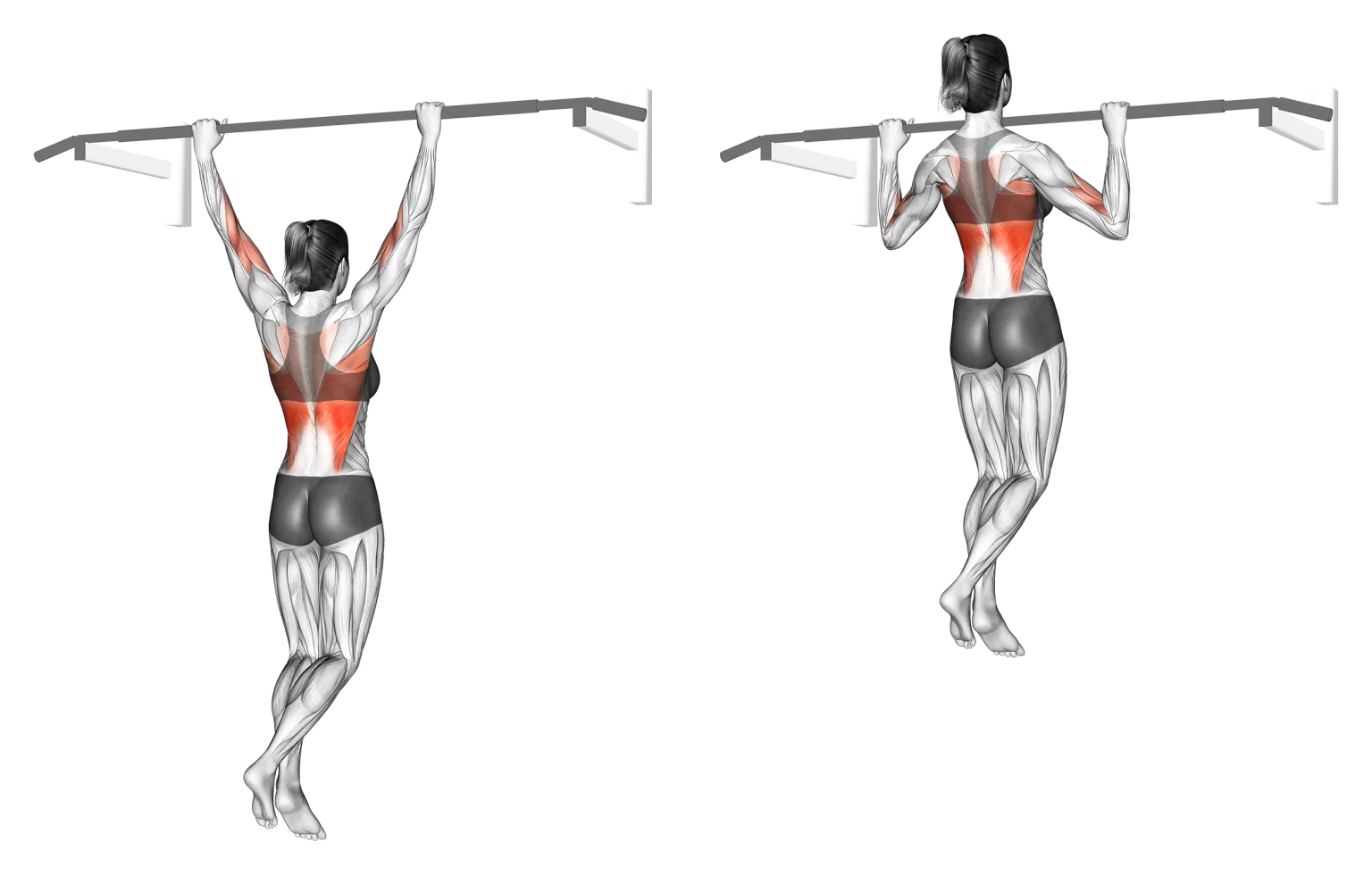
Muscles Worked by Chin Ups
- Latissimus Dorsi (Lats): The primary muscle worked in chin-ups, the lats are responsible for pulling your arms down towards your body. They are the large, fan-shaped muscles on the sides of your back.
- Biceps Brachii: These muscles in the front of your upper arms assist in the chin-up movement by bending your elbows and pulling your body up towards the bar.
- Forearms: Your forearms are crucial for gripping the pull-up bar and maintaining your grip throughout the exercise. They work isometrically, meaning they contract forcefully while remaining in a static position.
- Trapezius: The trapezius muscles, located in the upper back and neck, play a supporting role in chin-ups. They help stabilize your shoulders and maintain proper posture.
Behind the Neck Pull Up
Behind-the-neck (BTN) pull-ups are a variation of pull-ups that target the upper back muscles, specifically the latissimus dorsi (lats) and rhomboids. They also work the biceps, forearms, and core.
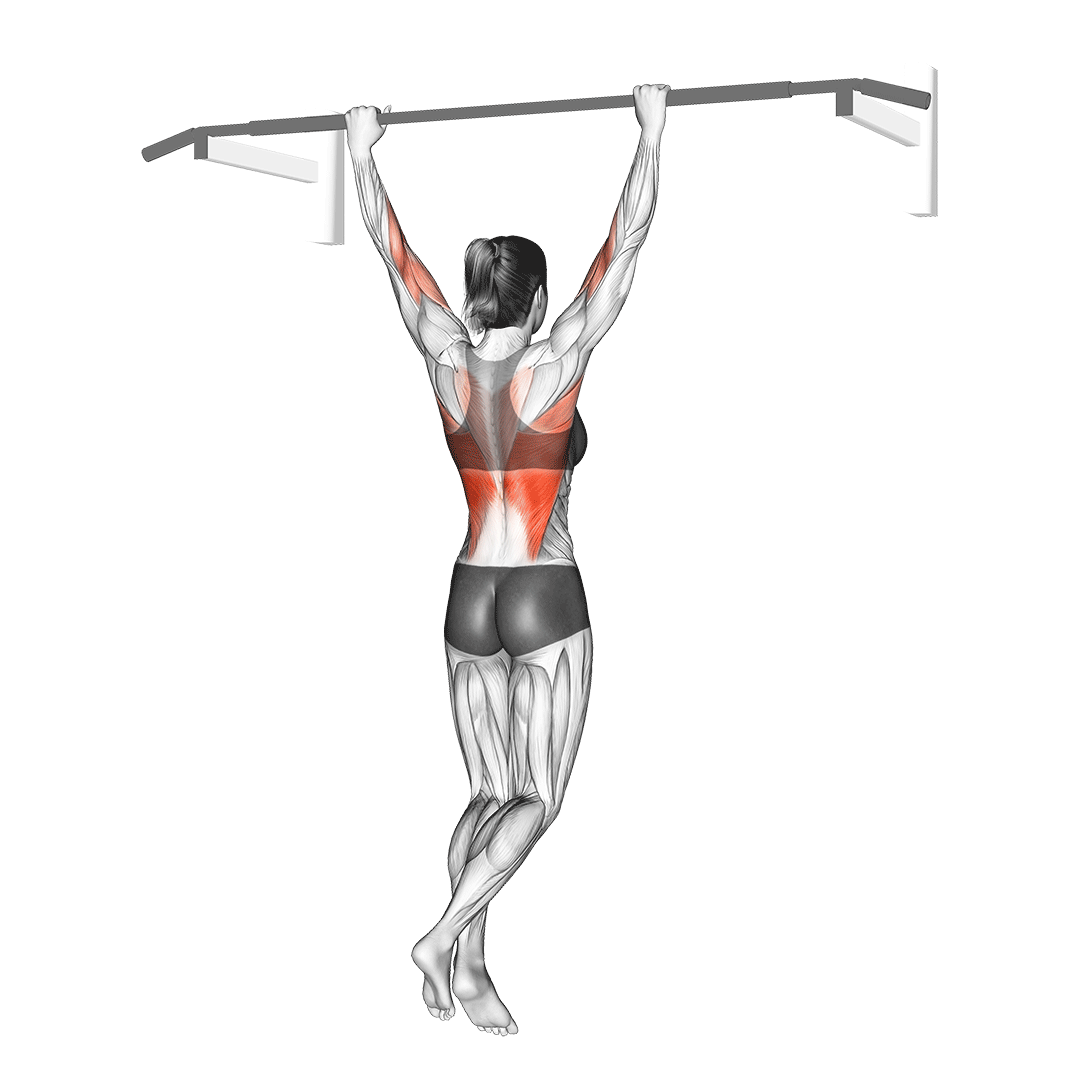
How to Do Behind the Neck Pull Ups
- Warm-up: Start with a light cardio activity like jogging in place or jumping jacks to elevate your heart rate and warm up your muscles. Dynamic stretches like arm circles and shoulder rolls can further prepare your body for the exercise.
- Grip the Pull-Up Bar: Hang from a sturdy pull-up bar with your hands wider than shoulder-width apart and palms facing towards you. This grip allows you to pull your elbows further back, engaging the lats and rhomboids more effectively.
- Engage Your Core: To maintain stability and prevent injuries, engage your core muscles by pulling your belly button towards your spine. This creates a tight core that supports your spine and allows for better form.
- Initiate the Movement: With your arms straight, slowly pull yourself up towards the bar, keeping your chin behind the bar as you reach the top position. Squeeze your lats and rhomboids throughout the movement.
- Controlled Descent: Slowly lower yourself back down to the starting position, keeping your arms straight and maintaining a controlled descent. Avoid swinging or using momentum to assist the movement.
- Repeat: Aim for 3 sets of as many repetitions as possible, taking short rest periods between sets.
Muscles Worked by Behind the Neck Pull Up
- Latissimus Dorsi (Lats): The primary muscle worked in BTN pull-ups, the lats are responsible for pulling your arms down towards your body. They are the large, fan-shaped muscles on the sides of your back.
- Rhomboids: These muscles located in the middle of your back, between your shoulder blades, are responsible for pulling your shoulder blades together. They play a crucial role in BTN pull-ups, assisting in the upward motion and keeping your shoulder blades stable.
- Biceps Brachii: These muscles in the front of your upper arms assist in the BTN pull-up movement by bending your elbows and pulling your body up towards the bar.
- Forearms: Your forearms are crucial for gripping the pull-up bar and maintaining your grip throughout the exercise. They work isometrically, meaning they contract forcefully while remaining in a static position.
- Trapezius: The trapezius muscles, located in the upper back and neck, play a supporting role in BTN pull-ups. They help stabilize your shoulders and maintain proper posture.
Chin Ups
Chin-ups are a compound exercise that works a variety of muscles in your upper body, including your back, biceps, forearms, and core. They are a great way to build strength and muscle mass, and they can also help you improve your grip strength and overall fitness.
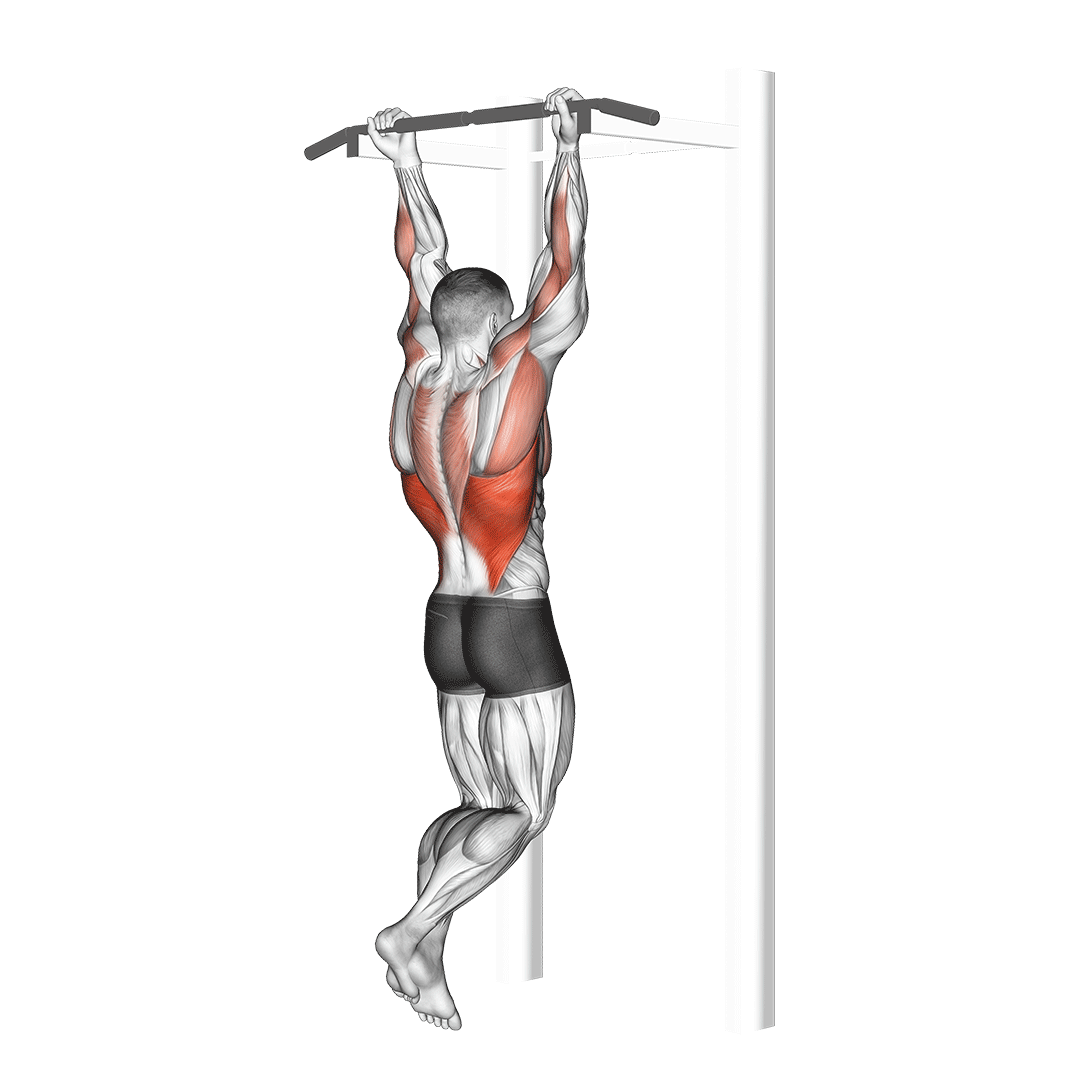
How to Do Chin Ups
- Warm-up: Before you start, warm up your muscles with light cardio and dynamic stretches. This will help to prevent injury.
- Grip the pull-up bar: Hang from a pull-up bar with your palms facing you and your hands shoulder-width apart. This is called a supinated grip.
- Engage your core: Tighten your abdominal muscles to help stabilize your body.
- Initiate the movement: Pull yourself up towards the bar until your chin is above the bar. Squeeze your back muscles, especially your lats, as you pull up.
- Controlled descent: Lower yourself back down to the starting position. Keep your body straight and avoid swinging.
- Repeat: Aim for 3 sets of as many repetitions as you can with proper form.
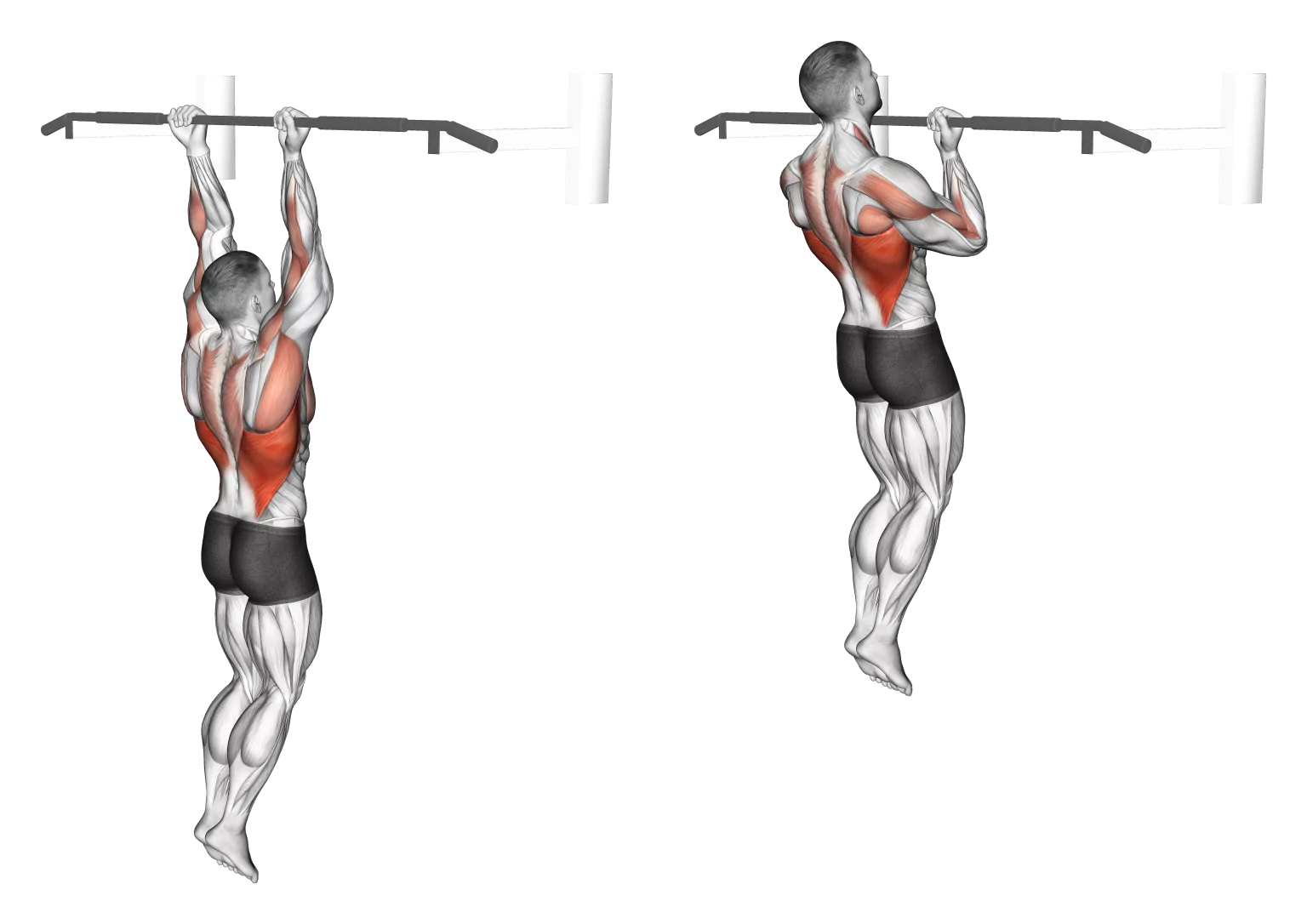
Muscles Worked by Chin Ups
- Latissimus dorsi (lats): The lats are the large, fan-shaped muscles that run along the sides of your back. They are the main muscle worked in chin-ups.
- Biceps brachii: The biceps are the muscles in the front of your upper arms. They assist in the chin-up movement by bending your elbows.
- Forearms: Your forearms are responsible for gripping the pull-up bar. They also work isometrically, meaning they contract forcefully while remaining in a static position.
- Trapezius: The trapezius is a large muscle that runs from your neck to your shoulders. It helps to stabilize your shoulders during the chin-up movement.
Weighted Chin Ups
Weighted chin-ups are a more challenging version of the classic chin-up exercise. By adding weight to the exercise, you increase the resistance and force your muscles to work harder, which can lead to faster muscle growth and strength gains.
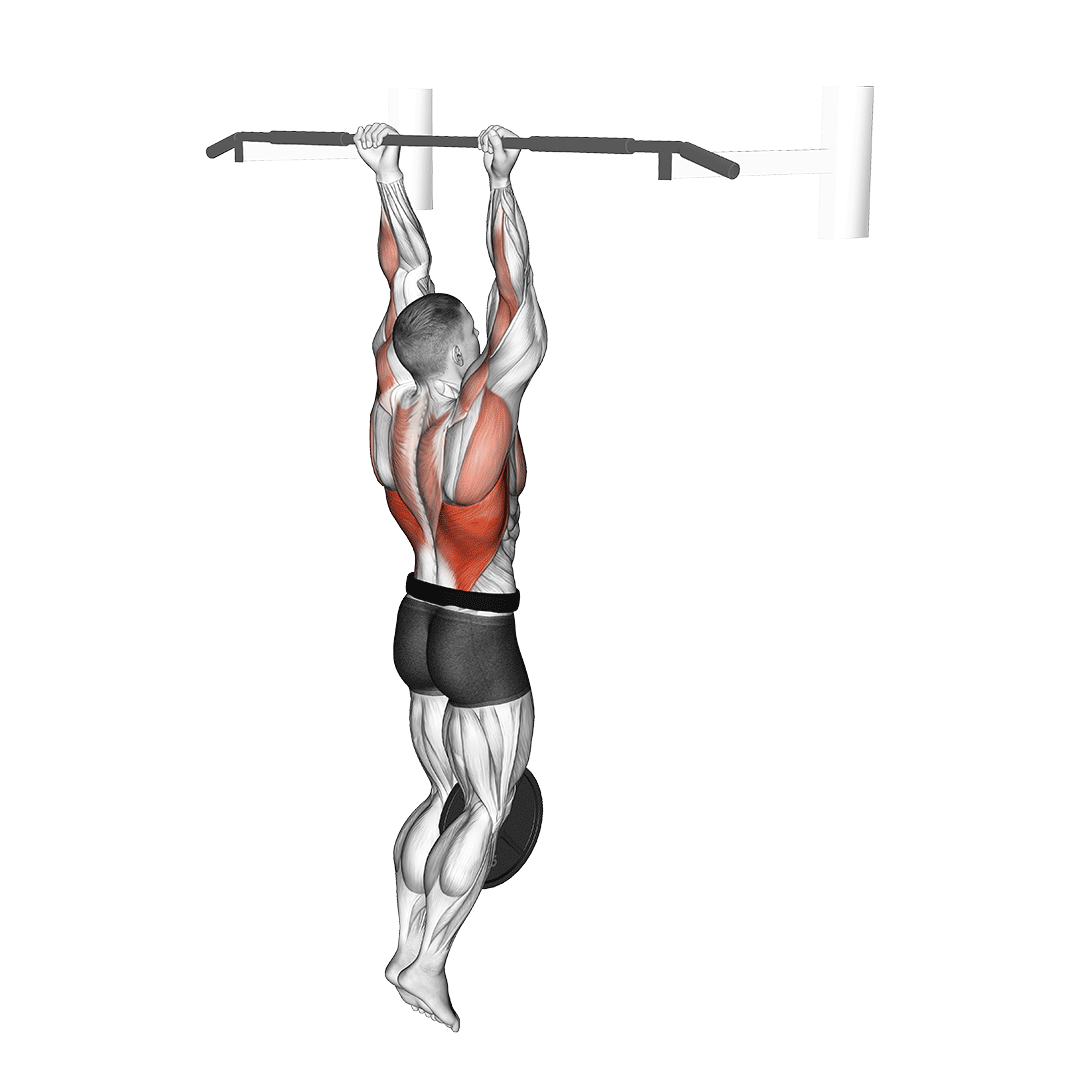
How to do Weighted Chin Ups
- Warm-up: Before you start, warm up your muscles with light cardio and dynamic stretches. This will help to prevent injury.
- Grip the pull-up bar: Hang from a sturdy pull-up bar with an overhand grip, which means your palms should be facing away from you. Your hands should be shoulder-width apart or slightly wider.
- Attach a weight belt: If you don’t have a weight belt, you can use a backpack or a chain to attach the weight to your waist.
- Engage your core: Tighten your abdominal muscles to help stabilize your body.
- Initiate the movement: Pull yourself up towards the bar until your chin is above the bar. Squeeze your back muscles, especially your lats, as you pull up.
- Controlled descent: Lower yourself back down to the starting position. Keep your body straight and avoid swinging.
- Repeat: Aim for 3 sets of as many repetitions as you can with proper form.
Muscles Worked by Weighted Chin Ups
- Latissimus dorsi (lats): The lats are the large, fan-shaped muscles that run along the sides of your back. They are the main muscle worked in chin-ups.
- Biceps brachii: The biceps are the muscles in the front of your upper arms. They assist in the chin-up movement by bending your elbows.
- Forearms: Your forearms are responsible for gripping the pull-up bar. They also work isometrically, meaning they contract forcefully while remaining in a static position.
- Trapezius: The trapezius is a large muscle that runs from your neck to your shoulders. It helps to stabilize your shoulders during the chin-up movement.
- Rhomboids: The rhomboids are muscles that lie between your shoulder blades. They help to pull your shoulder blades together.
Band Assisted Chin Up
Band-assisted chin-ups are a great way to build strength and muscle mass in your back, biceps, and forearms. They are also a good option for people who are new to chin-ups or who are not strong enough to do a full chin-up without assistance.
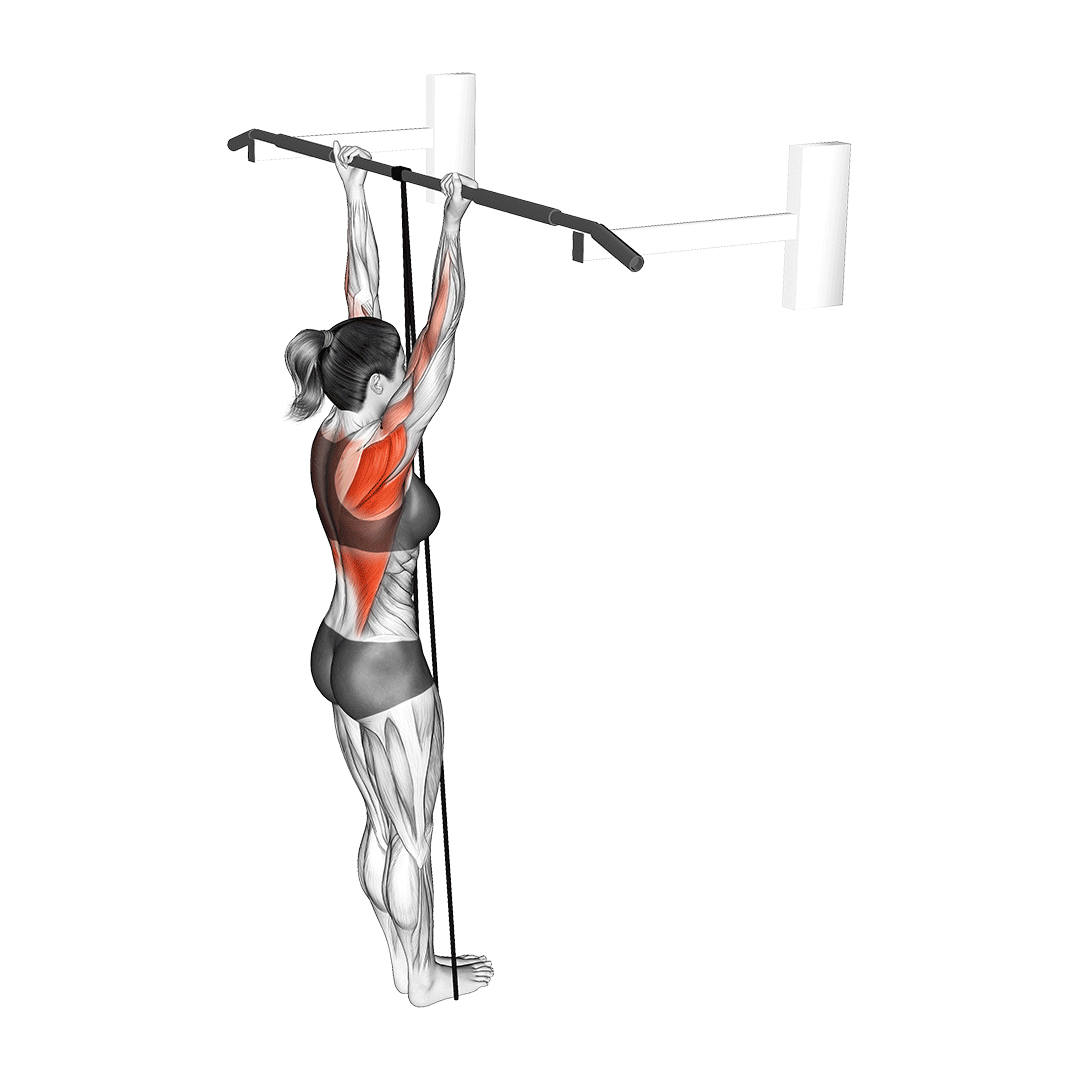
How to do Band Assisted Chin Up
- Warm up: Before you start, warm up your muscles with light cardio and dynamic stretches. This will help to prevent injury.
- Select a resistance band: Choose a resistance band that provides enough assistance that you can complete 8-12 repetitions of chin-ups with good form.
- Attach the band to the pull-up bar: Wrap the band around the pull-up bar so that it is taut.
- Step into the band: Step into the band with your feet so that your feet are shoulder-width apart.
- Grip the pull-up bar: Hang from the pull-up bar with your palms facing you and your hands shoulder-width apart.
- Engage your core: Tighten your abdominal muscles to help stabilize your body.
- Initiate the movement: Pull yourself up towards the bar until your chin is above the bar. Squeeze your back muscles, especially your lats, as you pull up.
- Controlled descent: Lower yourself back down to the starting position. Keep your body straight and avoid swinging.
- Repeat: Aim for 3 sets of as many repetitions as you can with proper form.
Muscles Worked by Band Assisted Chin Up
- Latissimus dorsi (lats): The lats are the large, fan-shaped muscles that run along the sides of your back. They are the main muscle worked in chin-ups.
- Biceps brachii: The biceps are the muscles in the front of your upper arms. They assist in the chin-up movement by bending your elbows.
- Forearms: Your forearms are responsible for gripping the pull-up bar. The also work isometrically, meaning they contract forcefully while remaining in a static position.
- Trapezius: The trapezius is a large muscle that runs from your neck to your shoulders. It helps to stabilize your shoulders during the chin-up movement.
Archer Pull Up
The archer pull-up is a challenging bodyweight exercise that targets the back muscles, biceps, and forearms. It’s a great way to build strength and muscle mass in these areas, and it can also improve your grip strength and overall fitness.
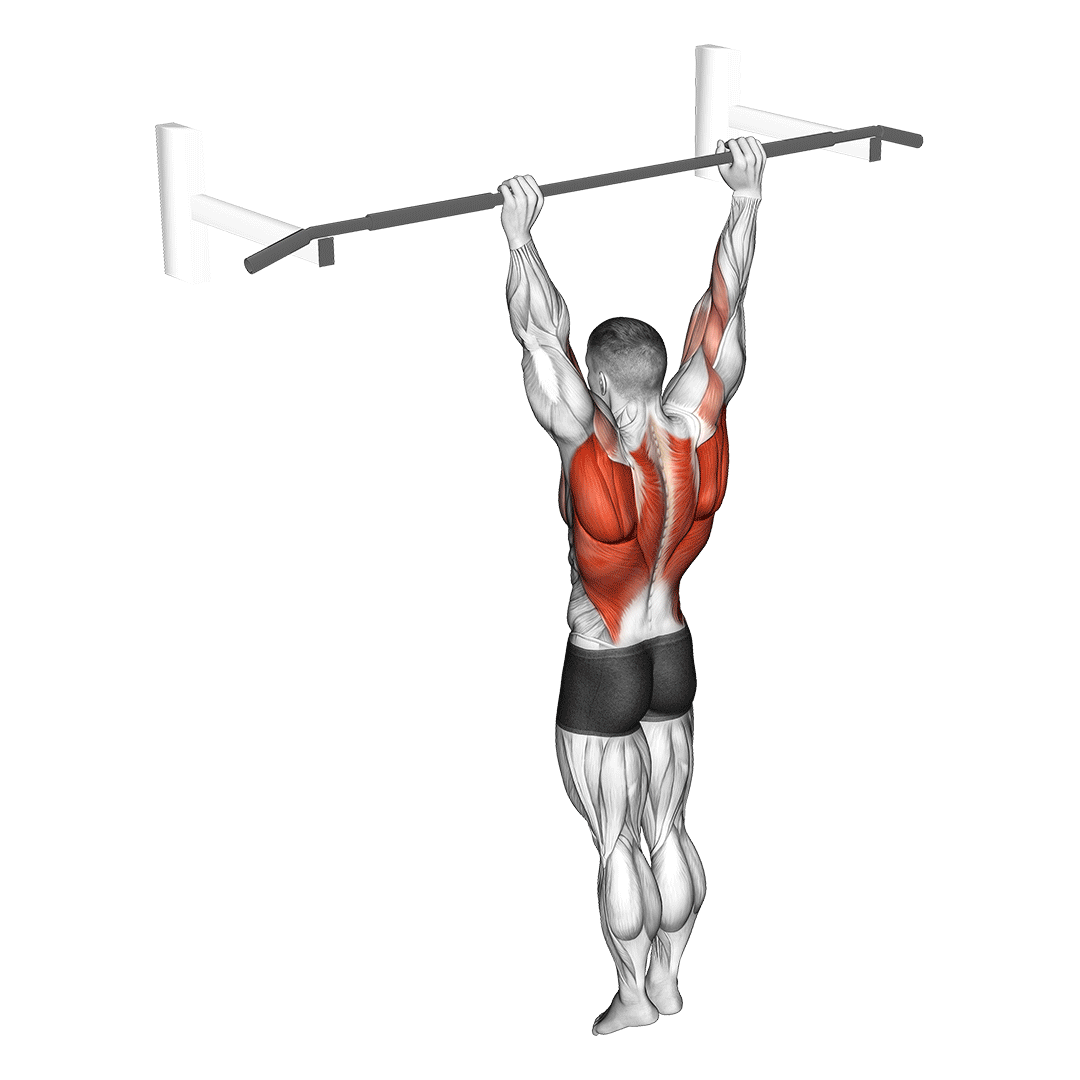
How to Do an Archer Pull Up
- Warm-up: Before you start, warm up your muscles with light cardio and dynamic stretches. This will help to prevent injury.
- Grip the pull-up bar: Hang from a pull-up bar with your hands shoulder-width apart. One hand should be pronated (palm facing away from you) and the other hand should be supinated (palm facing towards you). This is called a mixed grip.
- Engage your core: Tighten your abdominal muscles to help stabilize your body.
- Initiate the movement: Pull yourself up towards the bar until your chin is above the bar. Squeeze your back muscles, especially your lats, on the side of your body that is pronated.
- Controlled descent: Lower yourself back down to the starting position. Keep your body straight and avoid swinging.
- Repeat: Aim for 3 sets of as many repetitions as you can with proper form.
Muscles Worked by an Archer Pull Up
- Latissimus dorsi (lats): The lats are the large, fan-shaped muscles that run along the sides of your back. They are the main muscle worked in archer pull-ups.
- Biceps brachii: The biceps are the muscles in the front of your upper arms. They assist in the chin-up movement by bending your elbows.
- Forearms: Your forearms are responsible for gripping the pull-up bar. The also work isometrically, meaning they contract forcefully while remaining in a static position.
- Trapezius: The trapezius is a large muscle that runs from your neck to your shoulders. It helps to stabilize your shoulders during the chin-up movement.
- Rhomboids: The rhomboids are muscles that lie between your shoulder blades. They help to pull your shoulder blades together.
Commando Pull Ups
Commando pull-ups are a demanding bodyweight exercise that primarily targets the back muscles, biceps, and forearms. They’re an excellent way to build strength, muscle mass, and grip strength in these areas, while also enhancing overall fitness.
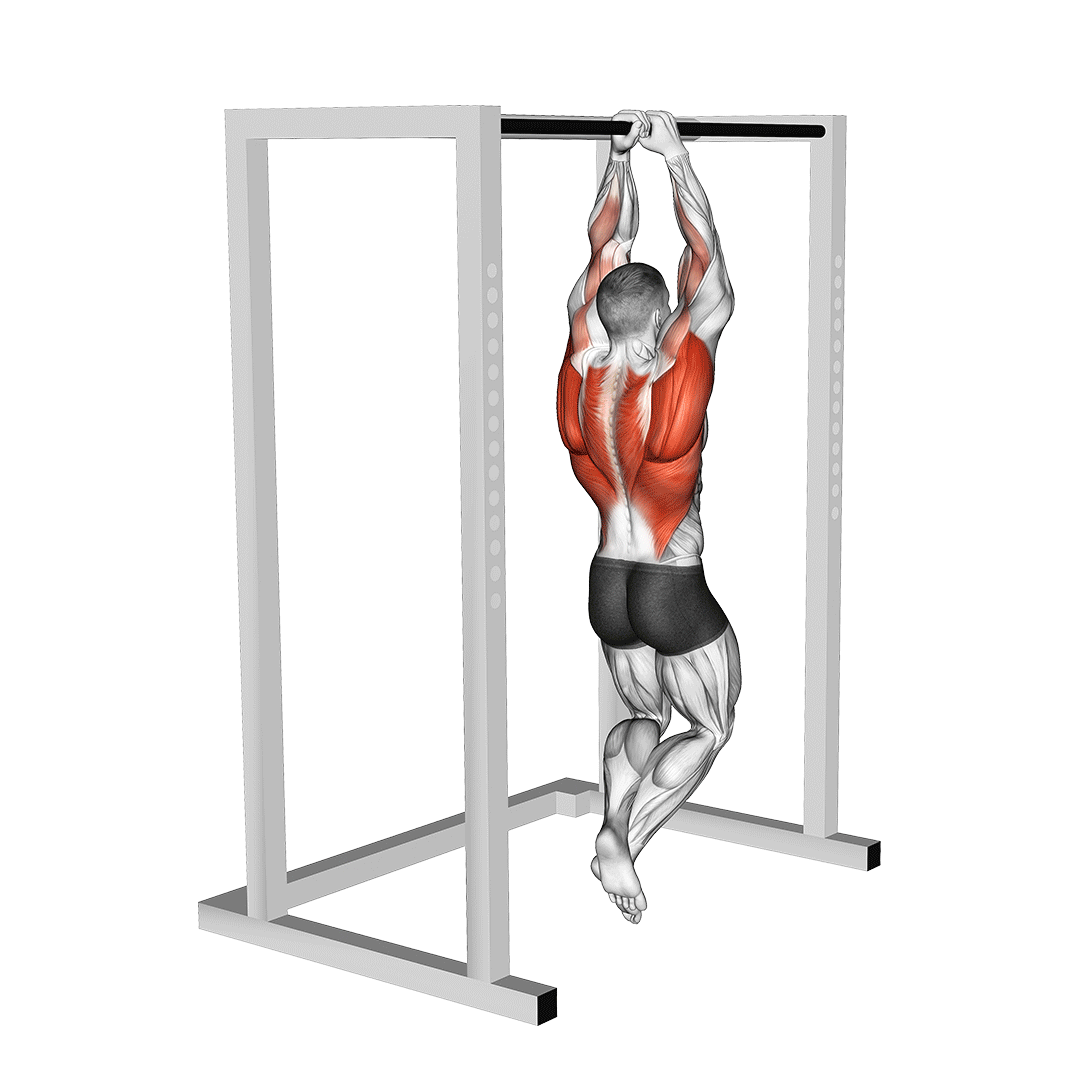
How to Do Commando Pull Ups
- Warm-up: Before embarking on this exercise, warm up your muscles with light cardio and dynamic stretches to prevent injuries.
- Grip the Pull-Up Bar: Hang from a pull-up bar with your hands shoulder-width apart, one hand in a pronated (palm facing away from you) grip and the other in a supinated (palm facing towards you) grip—a mixed grip.
- Engage Your Core: Activate your abdominal muscles to stabilize your body throughout the movement.
- Initiate the Movement: Pull yourself up towards the bar until your chin is above the bar. Focus on engaging your lats, particularly on the side with the supinated grip.
- Controlled Descent: Lower yourself back down to the starting position while maintaining a straight body alignment. Avoid swinging to assist the movement.
- Repeat: Aim for 3 sets of as many repetitions as you can maintain proper form.
Muscles Worked by Commando Pull Ups
- Latissimus Dorsi (Lats): The lats are the large, fan-shaped muscles that run along the sides of your back. They are the primary muscle involved in commando pull-ups.
- Biceps Brachii: Located in the front of the upper arms, the biceps assist in pulling yourself up by bending your elbows.
- Forearms: The forearms are responsible for gripping the pull-up bar, working isometrically to maintain a firm grasp throughout the exercise.
- Trapezius: A large muscle spanning from the neck to the shoulders, the trapezius helps stabilize the shoulders during the pulling motion.
- Rhomboids: Situated between the shoulder blades, the rhomboids assist in pulling the shoulder blades together, contributing to the overall movement.
Assisted Pull Up
Assisted pull-ups are a versatile exercise that provides support, allowing individuals with various fitness levels to engage their back muscles effectively. It targets the latissimus dorsi (lats), biceps brachii, forearms, trapezius, and rhomboids.
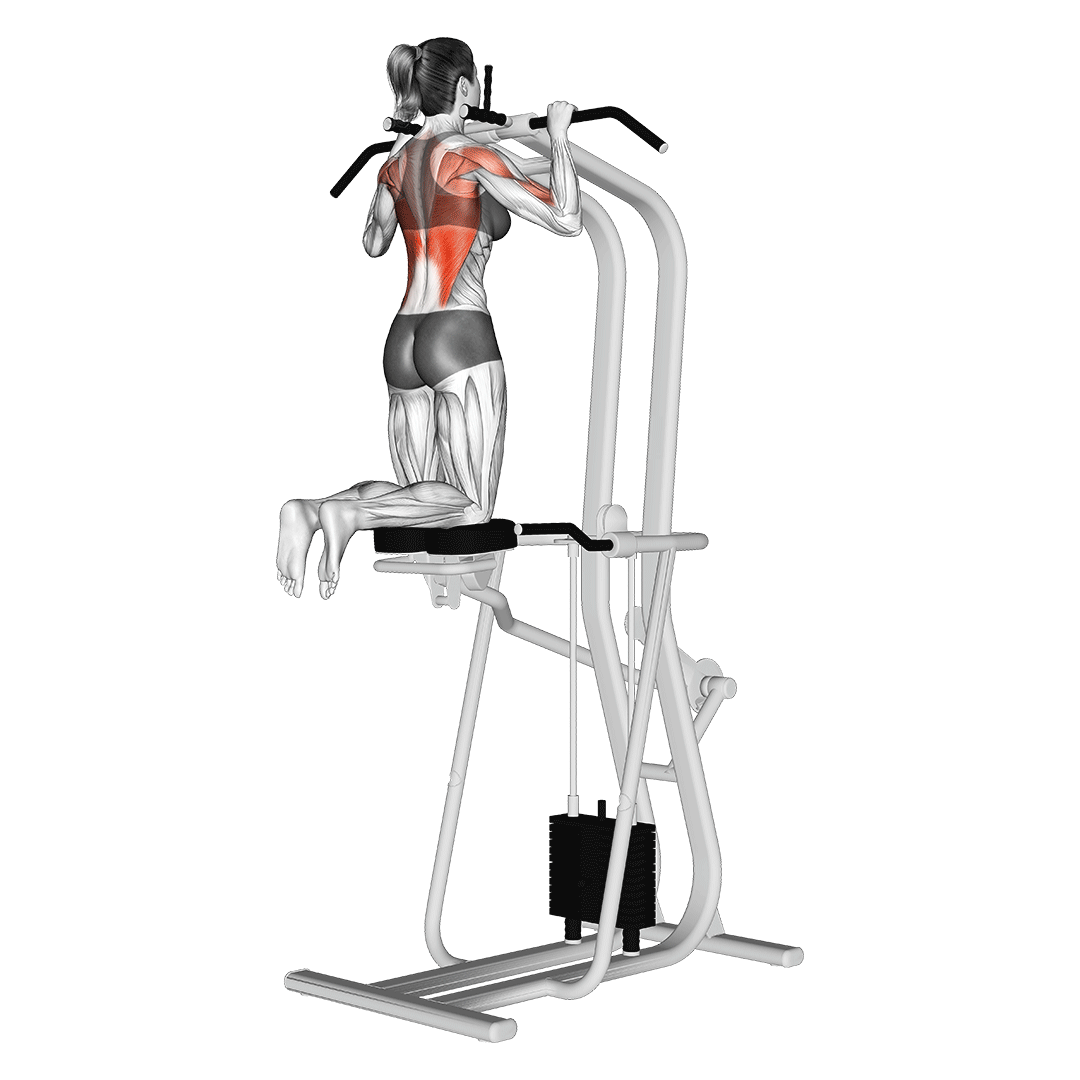
How to Do Assisted Pull Ups
- Warm-up: Before proceeding, warm up your muscles with light cardio and dynamic stretches to prevent injuries.
- Select an Assistance Method: Choose a suitable assistance method, such as a resistance band or a chair assist.
- Grip the Pull-Up Bar: Hang from the pull-up bar with your hands shoulder-width apart. Ensure your grip is comfortable and secure.
- Engage Your Core: Activate your abdominal muscles to stabilize your body throughout the movement.
- Initiate the Movement: Pull yourself up towards the bar until your chin is above the bar. Focus on engaging your back muscles, particularly the lats.
- Controlled Descent: Lower yourself back down to the starting position while maintaining a straight body alignment. Avoid swinging to assist the movement.
- Repeat: Aim for 3 sets of as many repetitions as you can maintain proper form.
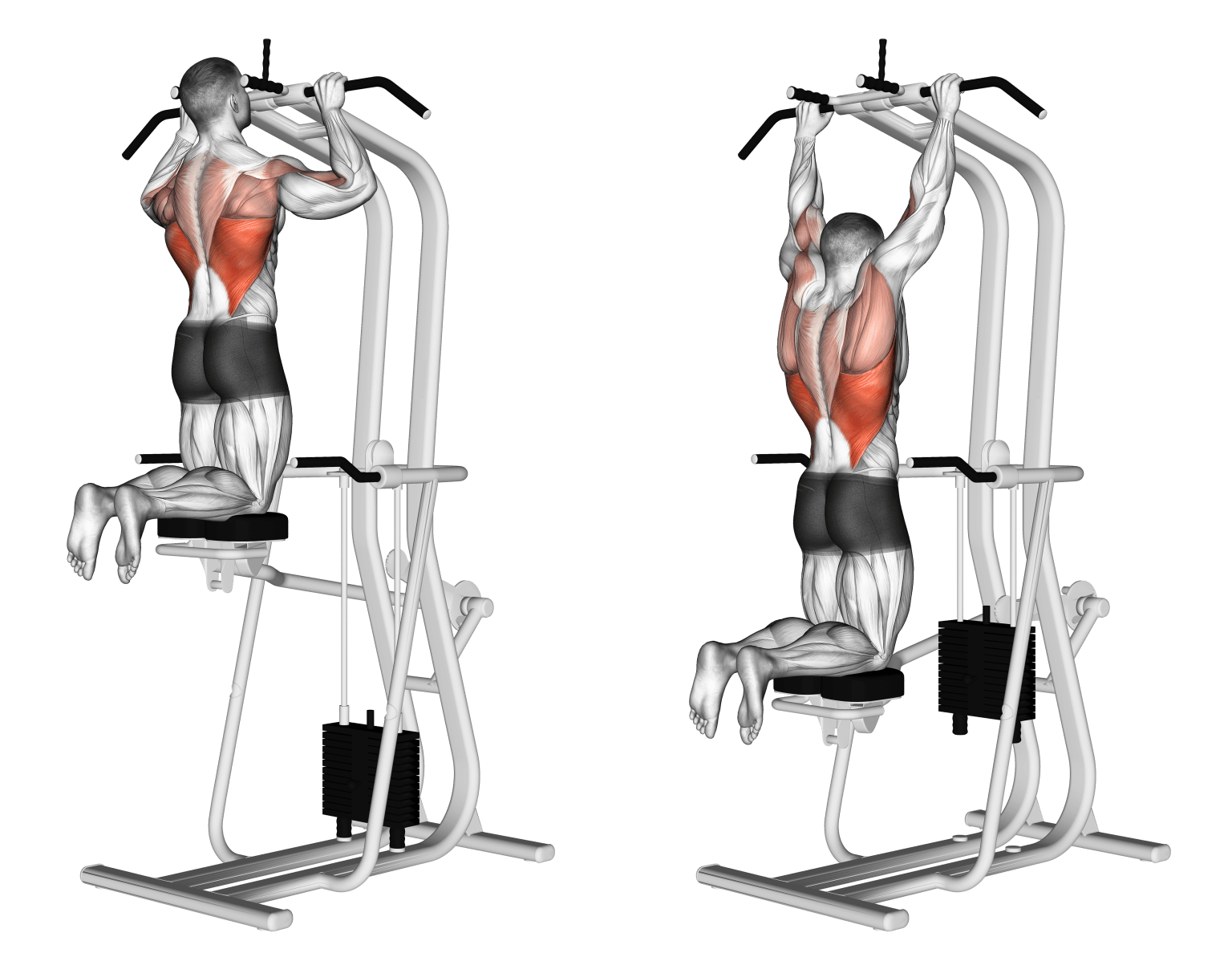
Muscles Worked Assisted Pull Ups
- Latissimus Dorsi (Lats): The large, fan-shaped muscles that run along the sides of your back. They are the primary muscle worked in assisted pull-ups.
- Biceps Brachii: Located in the front of the upper arms, the biceps assist in pulling yourself up by bending your elbows.
- Forearms: The forearms are responsible for gripping the pull-up bar, working isometrically to maintain a firm grasp throughout the exercise.
- Trapezius: A large muscle spanning from the neck to the shoulders, the trapezius helps stabilize the shoulders during the pulling motion.
- Rhomboids: Situated between the shoulder blades, the rhomboids assist in pulling the shoulder blades together, contributing to the overall movement.
Band Assisted Pull Up
Band-assisted pull-ups are a versatile exercise that provides support, enabling individuals of varying fitness levels to engage their back muscles effectively. It targets the latissimus dorsi (lats), biceps brachii, forearms, trapezius, and rhomboids.
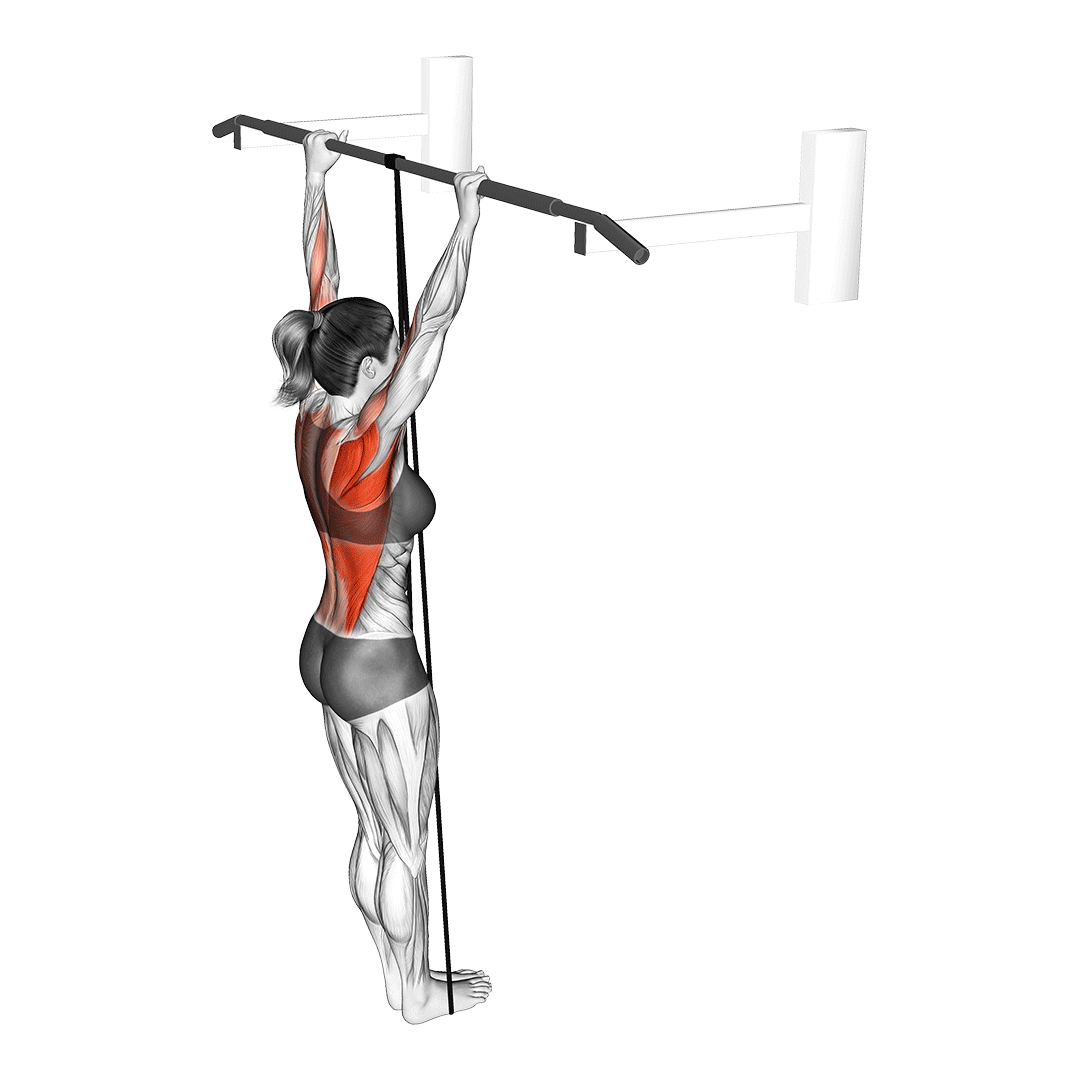
How to Do Band Assisted Pull Up
- Warm-up: Before embarking on this exercise, warm up your muscles with light cardio and dynamic stretches to prevent injuries.
- Select a Resistance Band: Choose a resistance band that provides the appropriate level of assistance. Start with a lighter resistance and gradually increase as you get stronger.
- Attach the Band to the Pull-Up Bar: Attach the band to the pull-up bar, ensuring it is taut and provides a comfortable level of support.
- Grip the Pull-Up Bar: Hang from the pull-up bar with your hands shoulder-width apart. Ensure your grip is comfortable and secure.
- Engage Your Core: Activate your abdominal muscles to stabilize your body throughout the movement.
- Initiate the Movement: Pull yourself up towards the bar until your chin is above the bar. Focus on engaging your back muscles, particularly the lats.
- Controlled Descent: Lower yourself back down to the starting position while maintaining a straight body alignment. Avoid swinging to assist the movement.
- Repeat: Aim for 3 sets of as many repetitions as you can maintain proper form.
Muscles Worked by Band Assisted Pull Up
- Latissimus Dorsi (Lats): The large, fan-shaped muscles that run along the sides of your back. They are the primary muscle worked in band-assisted pull-ups.
- Biceps Brachii: Located in the front of the upper arms, the biceps assist in pulling yourself up by bending your elbows.
- Forearms: The forearms are responsible for gripping the pull-up bar, working isometrically to maintain a firm grasp throughout the exercise.
- Trapezius: A large muscle spanning from the neck to the shoulders, the trapezius helps stabilize the shoulders during the pulling motion.
- Rhomboids: Situated between the shoulder blades, the rhomboids assist in pulling the shoulder blades together, contributing to the overall movement.
Close Grip Pull Up
The close-grip pull-up is a variation of the traditional pull-up that primarily targets the latissimus dorsi (lats) and biceps brachii, while also engaging the forearms, trapezius, and rhomboids.
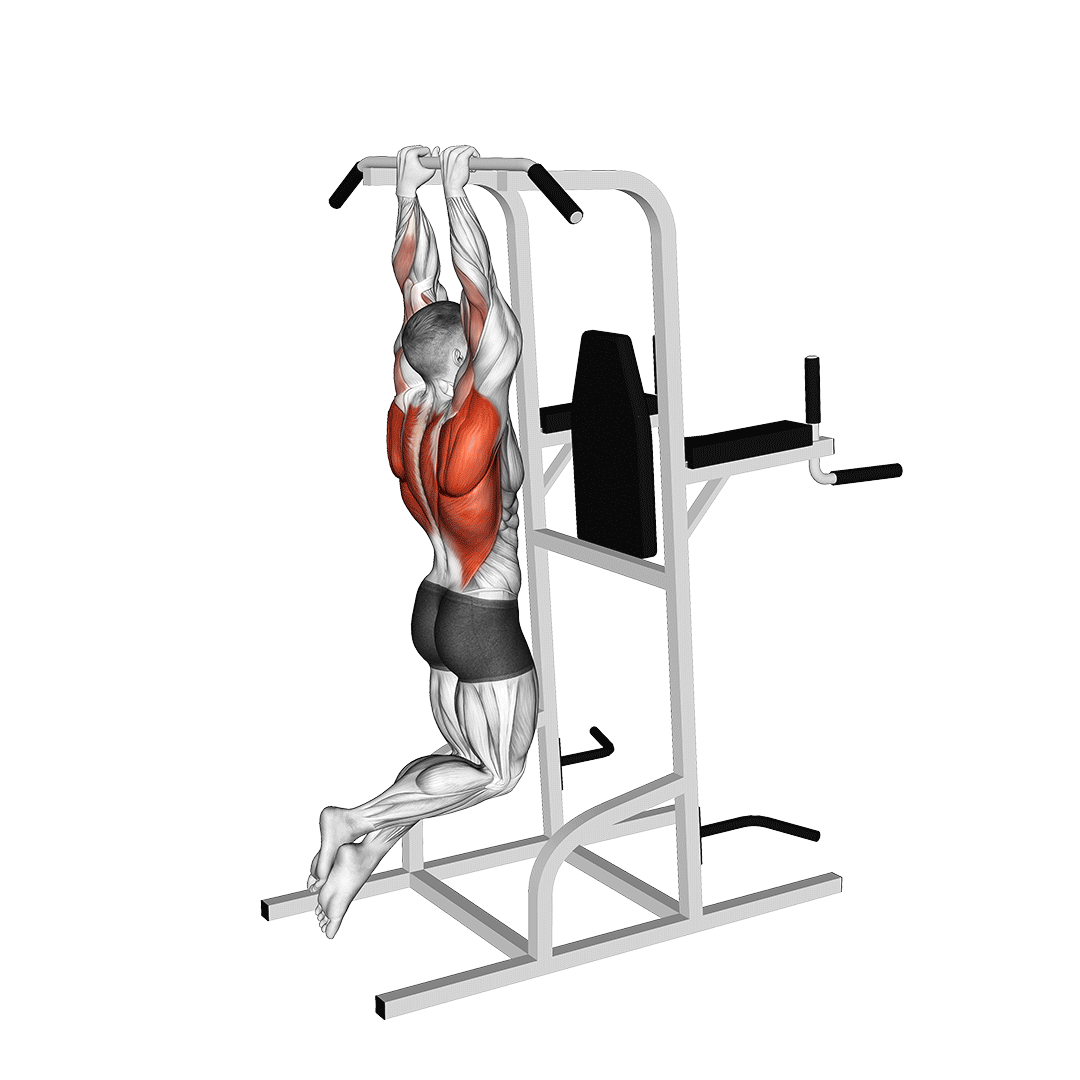
How to Do Close Grip Pull Up
- Warm-up: Before commencing the exercise, warm up your muscles with light cardio and dynamic stretches to prevent injuries.
- Grip the Pull-Up Bar: Hang from the pull-up bar with your hands shoulder-width apart or slightly closer. Your hands should be pronated, meaning your palms should face away from you.
- Engage Your Core: Activate your abdominal muscles to stabilize your body throughout the movement.
- Initiate the Movement: Pull yourself up towards the bar until your chin is above the bar. Focus on engaging your back muscles, particularly the lats.
- Controlled Descent: Lower yourself back down to the starting position while maintaining a straight body alignment. Avoid swinging to assist the movement.
- Repeat: Aim for 3 sets of as many repetitions as you can maintain proper form.
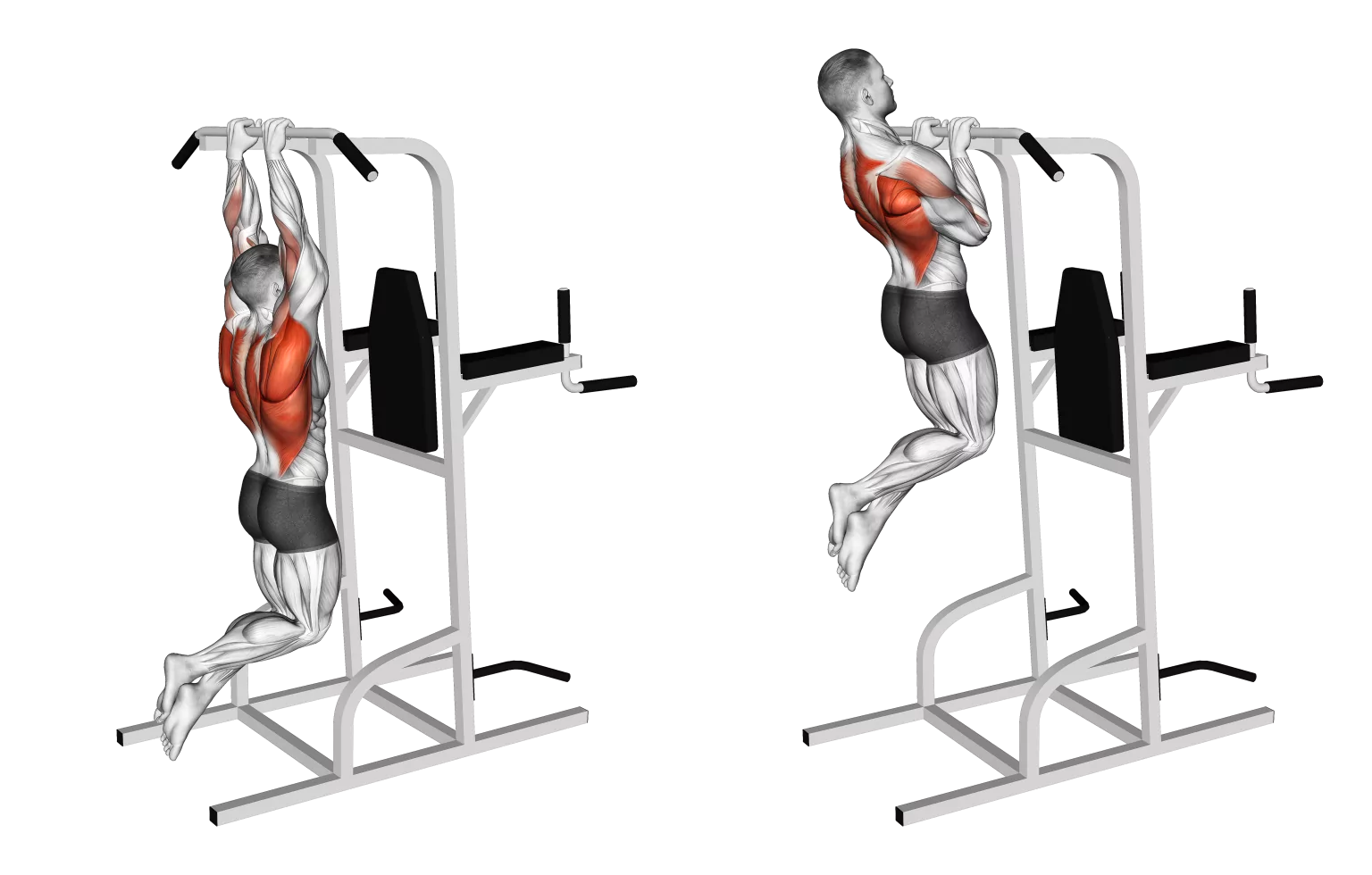
Muscles Worked by Close Grip Pull Up
- Latissimus Dorsi (Lats): The large, fan-shaped muscles that run along the sides of your back. They are the primary muscle worked in close-grip pull-ups due to the closer grip.
- Biceps Brachii: Located in the front of the upper arms, the biceps assist in pulling yourself up by bending your elbows.
- Forearms: The forearms are responsible for gripping the pull-up bar, working isometrically to maintain a firm grasp throughout the exercise.
- Trapezius: A large muscle spanning from the neck to the shoulders, the trapezius helps stabilize the shoulders during the pulling motion.
- Rhomboids: Situated between the shoulder blades, the rhomboids assist in pulling the shoulder blades together, contributing to the overall movement.
Neutral Grip Pull Ups
The neutral-grip pull-up is another variation of the traditional pull-up, focusing on evenly engaging the latissimus dorsi (lats), biceps brachii, and forearms, while also contributing to shoulder health and stability.
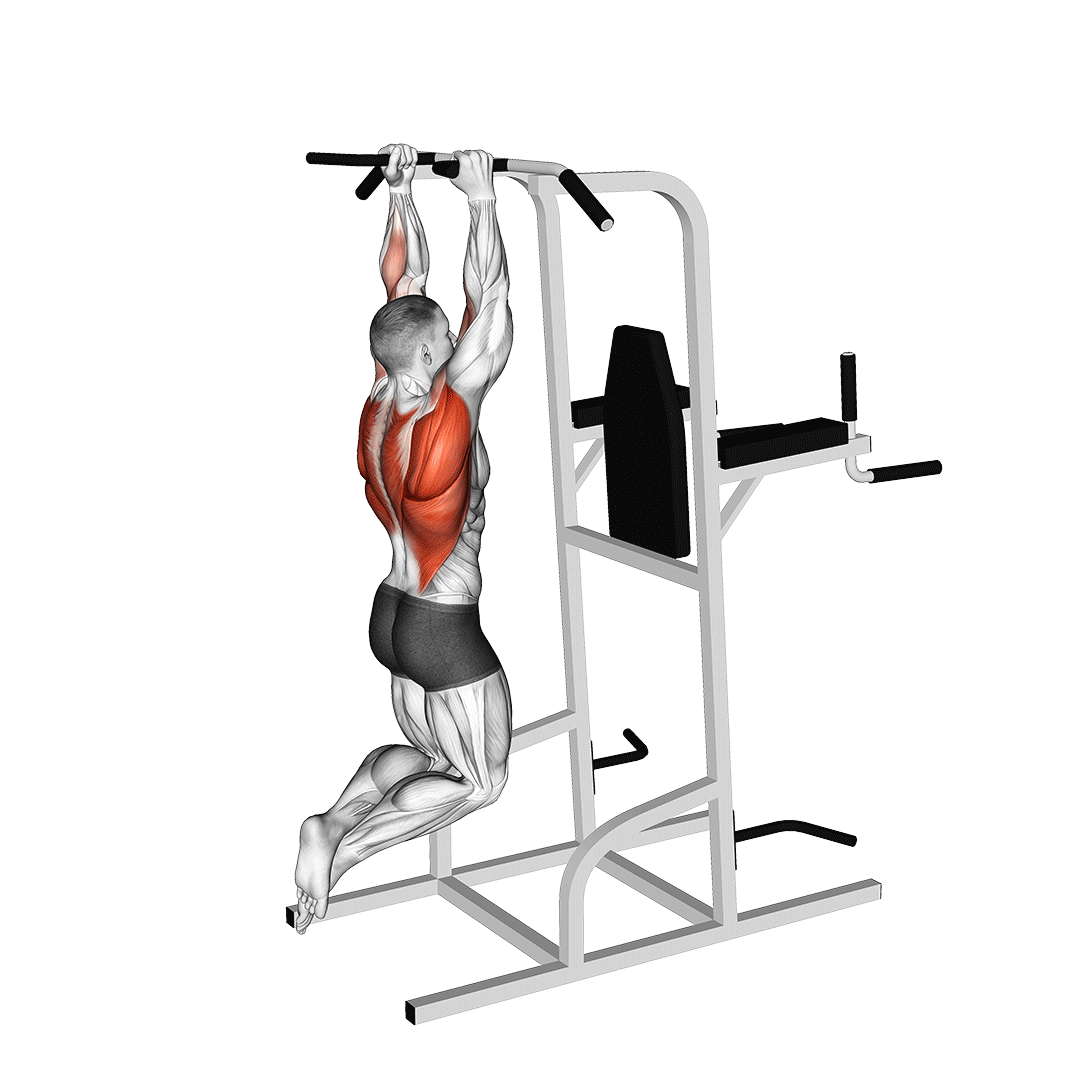
How to Do Neutral Grip Pull Ups
- Warm-up: Before embarking on the exercise, warm up your muscles with light cardio and dynamic stretches to prevent injuries.
- Grip the Pull-Up Bar: Hang from the pull-up bar with your hands shoulder-width apart, with your palms facing each other. Your hands should be turned slightly inwards to form a neutral grip.
- Engage Your Core: Activate your abdominal muscles to stabilize your body throughout the movement.
- Initiate the Movement: Pull yourself up towards the bar until your chin is above the bar. Focus on engaging your back muscles, particularly the lats.
- Controlled Descent: Lower yourself back down to the starting position while maintaining a straight body alignment. Avoid swinging to assist the movement.
- Repeat: Aim for 3 sets of as many repetitions as you can maintain proper form.
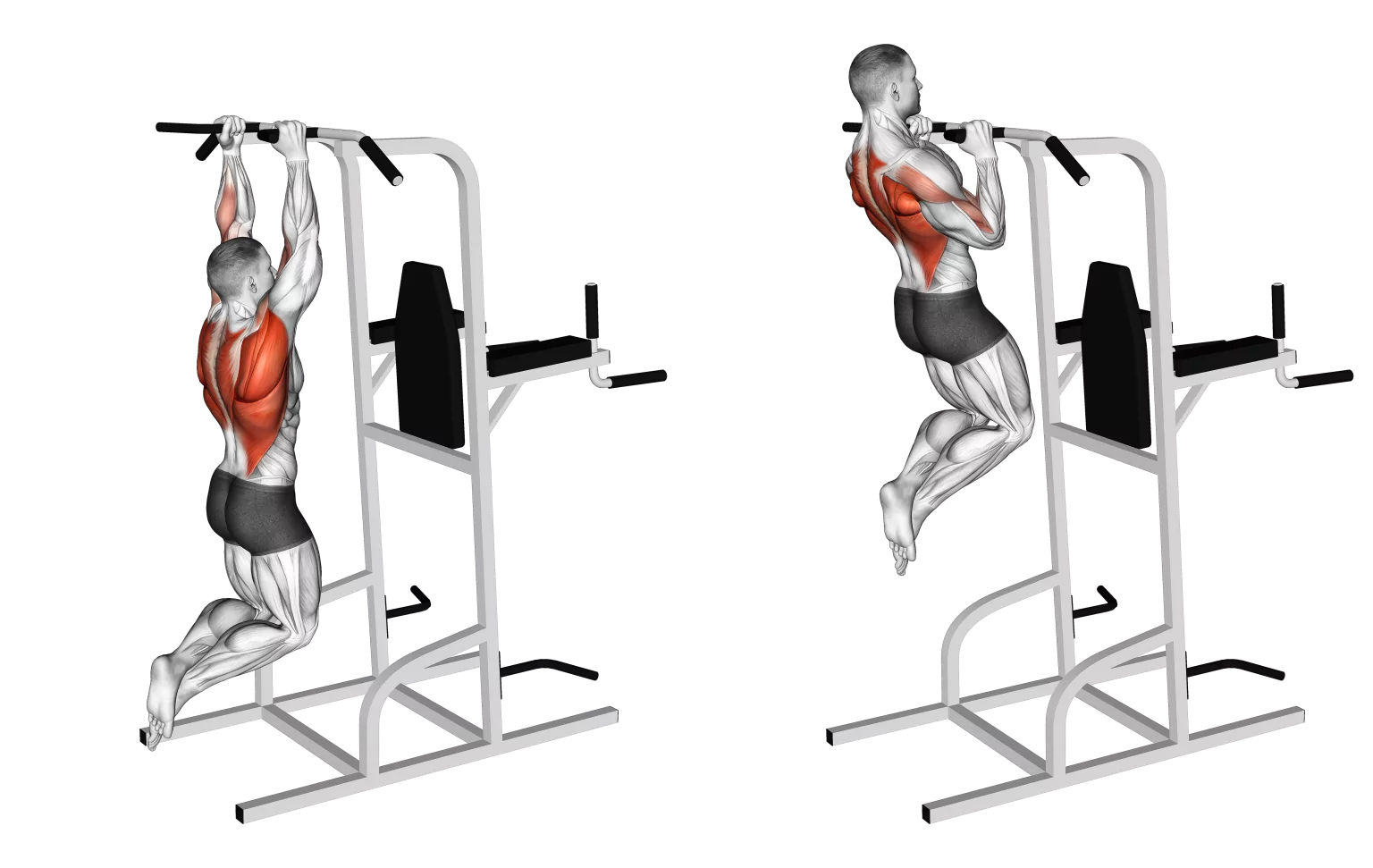
Muscles Worked by Neutral Grip Pull Ups
- Latissimus Dorsi (Lats): The large, fan-shaped muscles that run along the sides of your back. They are evenly worked in neutral-grip pull-ups due to the neutral grip.
- Biceps Brachii: Located in the front of the upper arms, the biceps assist in pulling yourself up by bending your elbows.
- Forearms: The forearms are responsible for gripping the pull-up bar, working isometrically to maintain a firm grasp throughout the exercise.
- Trapezius: A large muscle spanning from the neck to the shoulders, the trapezius helps stabilize the shoulders during the pulling motion.
- Rhomboids: Situated between the shoulder blades, the rhomboids assist in pulling the shoulder blades together, contributing to the overall movement.
Weighted Neutral Grip Pull Ups
Weighted neutral-grip pull-ups are a challenging variation of the traditional pull-up that intensifies the exercise by adding weight to increase resistance. This variation effectively targets the latissimus dorsi (lats), biceps brachii, and forearms, while also enhancing overall upper body strength and muscular development.
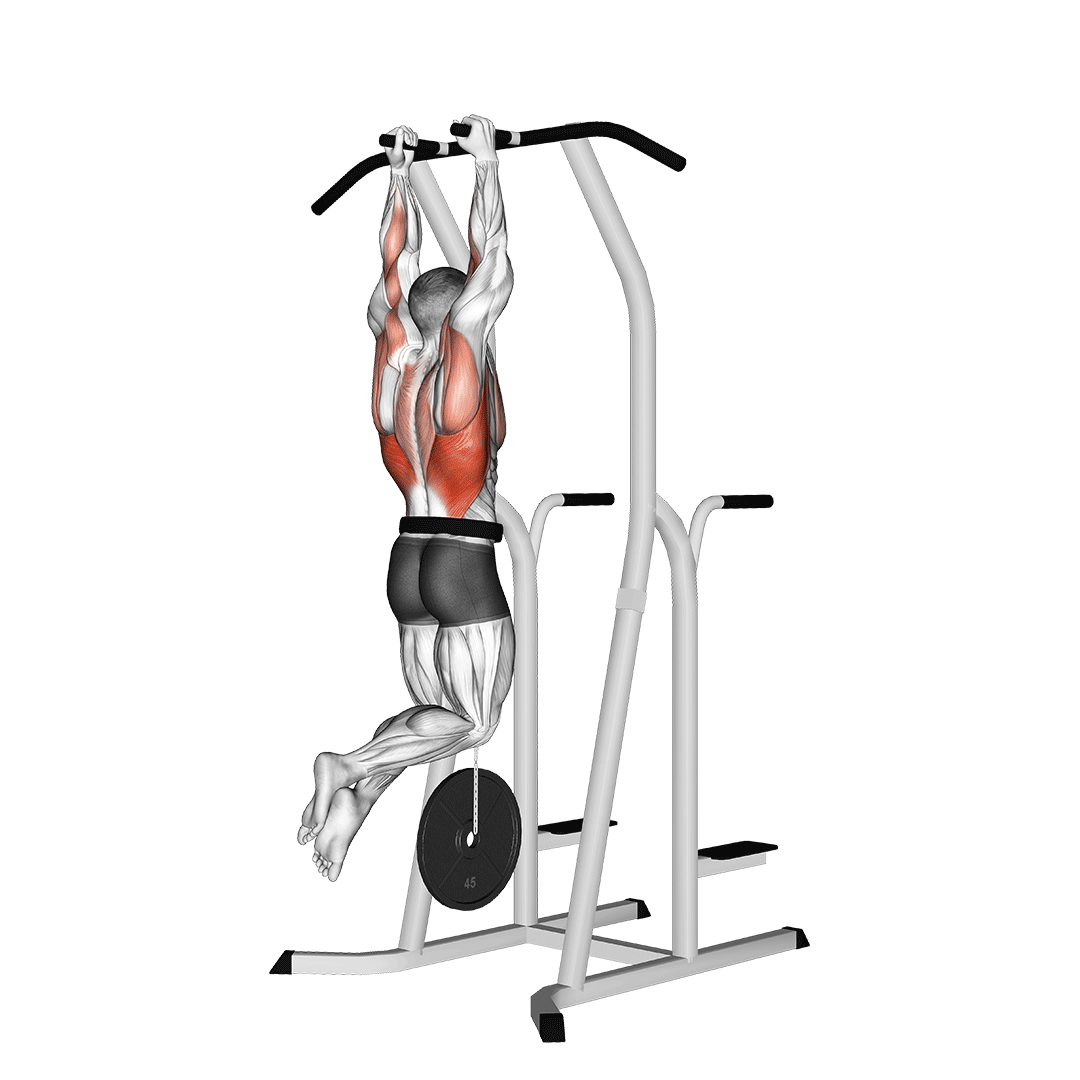
How to Do Weighted Neutral Grip Pull Ups
- Warm-up: Before commencing the exercise, warm up your muscles with light cardio and dynamic stretches to prevent injuries.
- Choose a Suitable Weight Belt: Select a weight belt that can safely accommodate the weight you plan to add. Start with a manageable weight and gradually increase as you get stronger.
- Attach Weight Plates to the Belt: Secure weight plates to the weight belt while ensuring the weight distribution is balanced.
- Grip the Pull-Up Bar: Hang from the pull-up bar with your hands shoulder-width apart, with your palms facing each other. Your hands should be turned slightly inwards to form a neutral grip.
- Engage Your Core: Activate your abdominal muscles to stabilize your body throughout the movement.
- Initiate the Movement: Pull yourself up towards the bar until your chin is above the bar. Focus on engaging your back muscles, particularly the lats.
- Controlled Descent: Lower yourself back down to the starting position while maintaining a straight body alignment. Avoid swinging to assist the movement.
- Repeat: Aim for 3 sets of as many repetitions as you can maintain proper form and control the weight.
Muscles Worked by Weighted Neutral Grip Pull Ups
- Latissimus Dorsi (Lats): The large, fan-shaped muscles that run along the sides of your back. They are the primary muscle worked in weighted neutral-grip pull-ups due to the neutral grip and increased resistance.
- Biceps Brachii: Located in the front of the upper arms, the biceps assist in pulling yourself up by bending your elbows.
- Forearms: The forearms are responsible for gripping the pull-up bar, working isometrically to maintain a firm grasp throughout the exercise.
- Trapezius: A large muscle spanning from the neck to the shoulders, the trapezius helps stabilize the shoulders during the pulling motion.
- Rhomboids: Situated between the shoulder blades, the rhomboids assist in pulling the shoulder blades together, contributing to the overall movement.
Muscle Up
The muscle-up is a compound exercise that combines a pull-up with a dip, resulting in a challenging movement that targets multiple muscle groups in the upper body. It is considered an advanced bodyweight exercise due to its demanding nature, requiring strength, coordination, and flexibility.
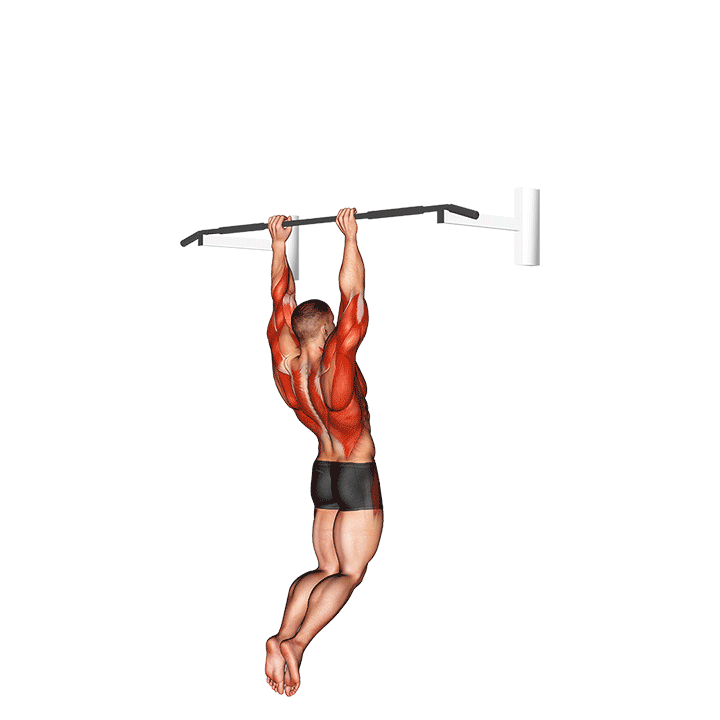
How to Do Muscle Up
- Warm-up: Before commencing the exercise, warm up your muscles with light cardio and dynamic stretches to prevent injuries.
- Grip the Pull-Up Bar: Hang from the pull-up bar with your hands shoulder-width apart, with your palms facing away from you (overhand grip).
- Engage Your Core: Activate your abdominal muscles to stabilize your body throughout the movement.
- Initiate the Pulling Phase: Pull yourself up towards the bar until your chin is above the bar. Focus on engaging your back muscles, particularly the lats.
- Transition Phase: As you reach the top of the pull-up, rotate your body and bring your chest towards the bar. Simultaneously, extend your arms and lean back, lowering your chest below the bar.
- Dipping Phase: Drive your feet up towards the bar, initiating the dip motion. Push yourself up until your arms are fully extended.
- Reverse Grip: Once you reach the top of the dip, rotate your grip so your palms face towards you (underhand grip).
- Lowering Phase: Slowly lower yourself down until your elbows are bent at a 90-degree angle.
- Repeat: Aim for 3 sets of as many repetitions as you can maintain proper form.
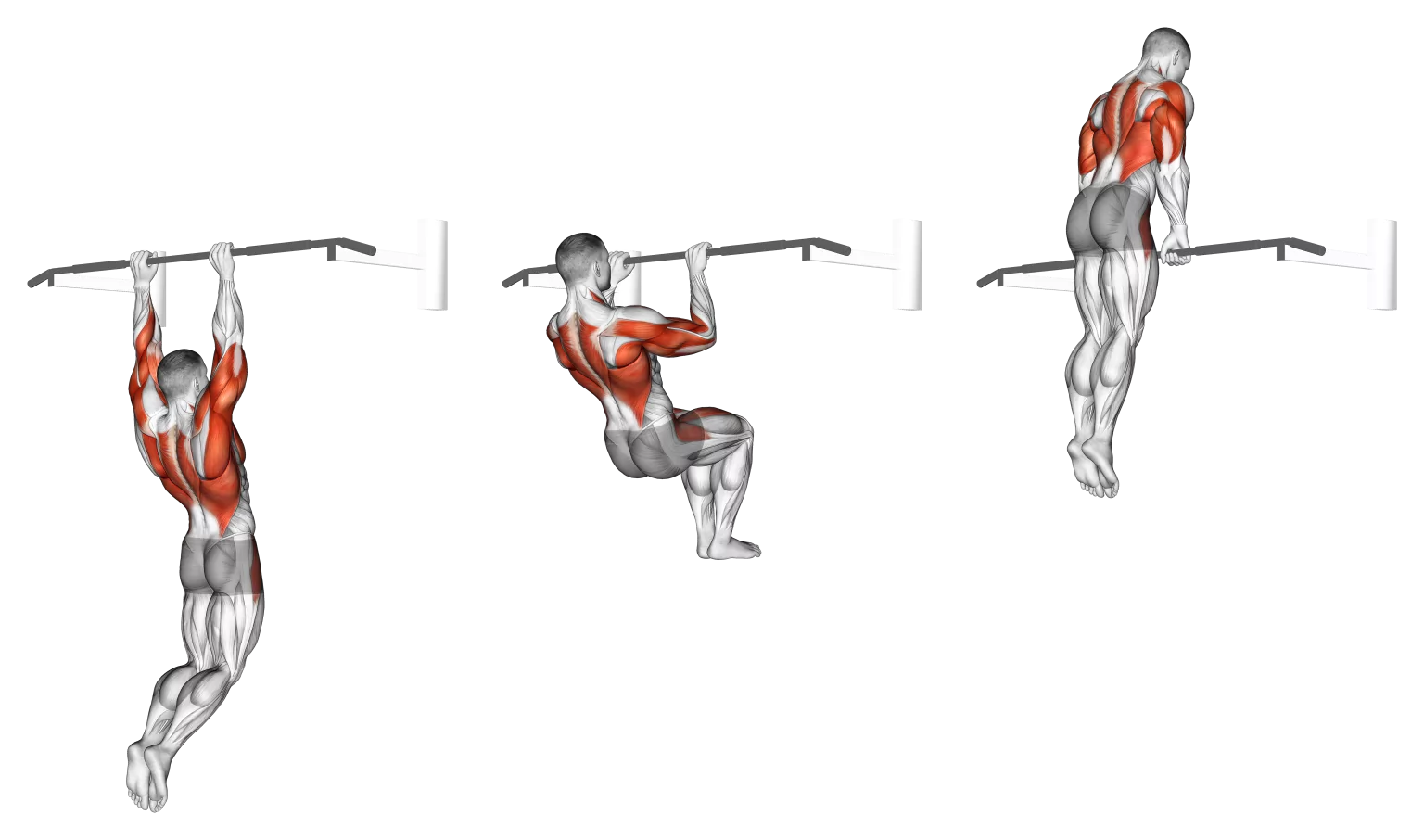
Muscles Worked by Muscle Up
- Latissimus Dorsi (Lats): The large, fan-shaped muscles that run along the sides of your back are the primary muscle worked in muscle-ups due to the extensive pulling motion.
- Biceps Brachii: Located in the front of the upper arms, the biceps assist in pulling yourself up and providing power during the dip phase.
- Triceps Brachii: Situated in the back of the upper arms, the triceps assist in extending your arms during the dip phase.
- Pectoralis Major: The large chest muscle is engaged during the dip phase.
- Shoulder Muscles: The anterior deltoids, medial deltoids, and posterior deltoids are all involved in stabilizing the shoulder joint during the pulling and lowering phases.
- Forearms: The forearms are responsible for gripping the pull-up bar throughout the entire movement.
Front Lever Pull Ups
The front lever pull-up is a challenging bodyweight exercise that requires a high level of upper body strength, flexibility, and core stability. It combines the isometric hold of a front lever with the pulling motion of a pull-up, making it an excellent exercise for developing a strong, well-rounded upper body.
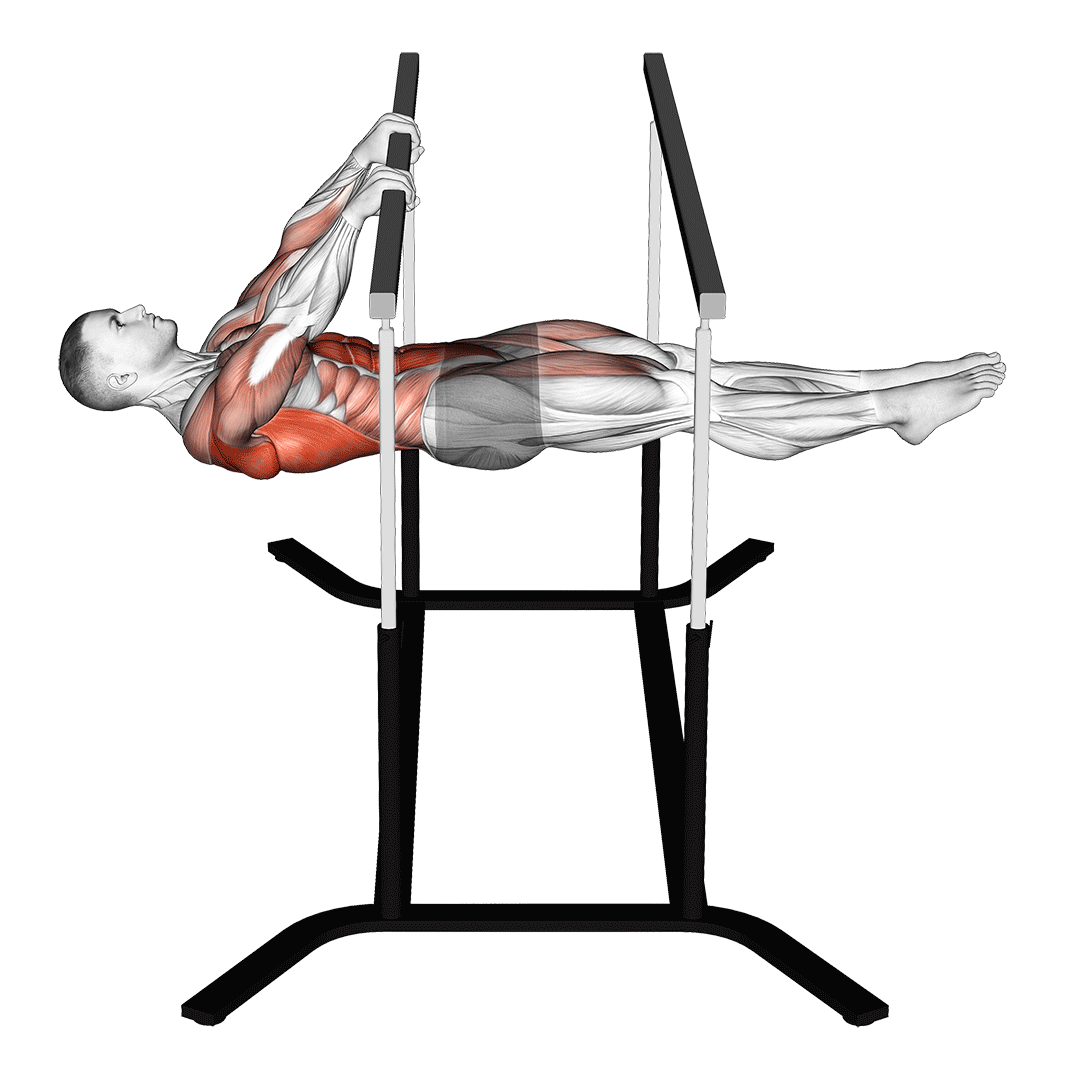
How to Do Front Lever Pull Ups
- Warm-up: Before commencing the exercise, warm up your muscles with light cardio and dynamic stretches to prevent injuries.
- Grasp the Pull-Up Bar: Grip the pull-up bar with your hands shoulder-width apart, with your palms facing away from you (overhand grip).
- Engage Your Core: Activate your abdominal muscles to stabilize your body throughout the movement.
- Initiate the Movement: Pull yourself up towards the bar until your chin is above the bar. Maintain a straight body alignment, with your chest and thighs parallel to the ground.
- Isometric Hold: Hold this position for as long as you can maintain proper form. Focus on activating your back muscles, particularly the lats, to maintain a straight body position.
- Descend: Slowly lower yourself down until your chin is below the bar. Maintain a controlled descent, engaging your lats to control the movement.
- Repeat: Aim for 3 sets of as many repetitions as you can maintain proper form.
Muscles Worked by Front Lever Pull Ups
- Latissimus Dorsi (Lats): The large, fan-shaped muscles that run along the sides of your back are the primary muscle worked in front lever pull-ups due to the isometric hold.
- Biceps Brachii: Located in the front of the upper arms, the biceps assist in pulling yourself up and providing power during the pulling phase.
- Triceps Brachii: Situated in the back of the upper arms, the triceps assist in extending your arms during the descending phase.
- Pectoralis Major: The large chest muscle is engaged during the isometric hold for stability.
- Shoulder Muscles: The anterior deltoids, medial deltoids, and posterior deltoids are all involved in stabilizing the shoulder joint during the pulling and isometric hold phases.
- Forearms: The forearms are responsible for gripping the pull-up bar throughout the entire movement.
Inclined Pull ups
The inclined pull-up is a variation of the traditional pull-up that is performed with the feet elevated, placing the body at an incline. This modification makes the exercise more accessible to individuals with lower upper body strength and allows for a greater range of motion, targeting the latissimus dorsi (lats) and biceps brachii more effectively.
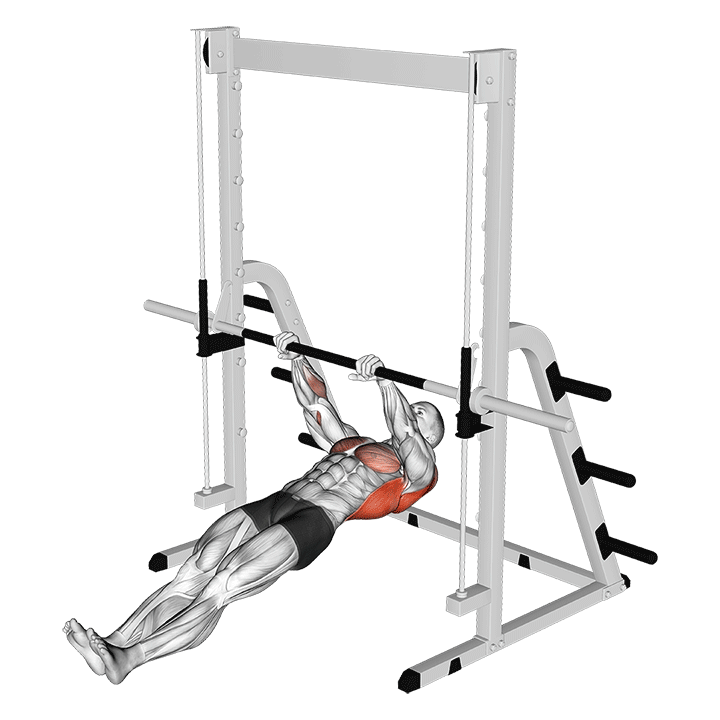
How to Do Inclined Pull ups
Warm-up: Before commencing the exercise, warm up your muscles with light cardio and dynamic stretches to prevent injuries.
Positioning:
- Adjust the Pull-Up Bar: Set the pull-up bar at a height that allows your feet to rest comfortably on a stable surface, such as a box or platform.
- Foot Placement: Place your feet flat on the surface, ensuring your body forms an incline of approximately 30-45 degrees.
Grip and Execution:
- Grasp the Pull-Up Bar: Grip the pull-up bar with a comfortable grip, either overhand, underhand, or neutral, depending on your preference and desired muscle focus.
- Engage Your Core: Activate your abdominal muscles to stabilize your body throughout the movement.
- Initiate the Pull: Pull yourself up towards the bar until your chin is above the bar. Focus on engaging your back muscles, particularly the lats.
- Slow and Controlled Descent: Slowly lower yourself back down to the starting position while maintaining a straight body alignment. Avoid swinging or using momentum to assist the movement.
- Repeat: Aim for 3 sets of as many repetitions as you can maintain proper form.
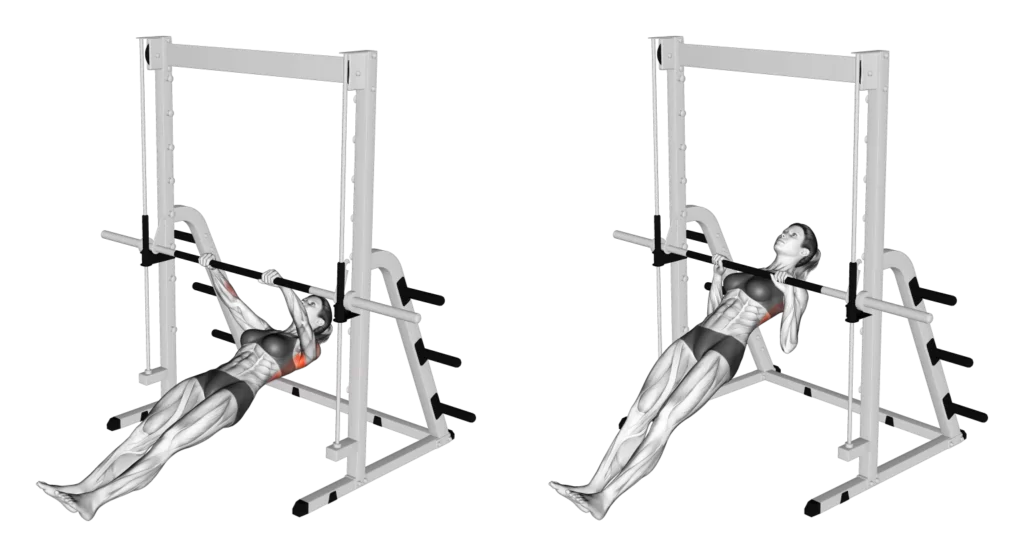
Muscles Worked by Inclined Pull ups
- Latissimus Dorsi (Lats): The large, fan-shaped muscles that run along the sides of your back are the primary muscle worked in inclined pull-ups due to the incline angle.
- Biceps Brachii: Located in the front of the upper arms, the biceps assist in pulling yourself up by bending your elbows.
- Pectoralis Major: The large chest muscle is engaged during the pulling motion.
- Shoulder Muscles: The anterior deltoids, medial deltoids, and posterior deltoids are all involved in stabilizing the shoulder joint during the pulling motion.
- Forearms: The forearms are responsible for gripping the pull-up bar throughout the entire movement.
Feet Elevated Inverted Rows
The feet elevated inverted row is a variation of the traditional inverted row that is performed with the feet elevated, placing the body at an incline. This modification makes the exercise more accessible to individuals with lower upper body strength and allows for a greater range of motion, targeting the latissimus dorsi (lats) more effectively.
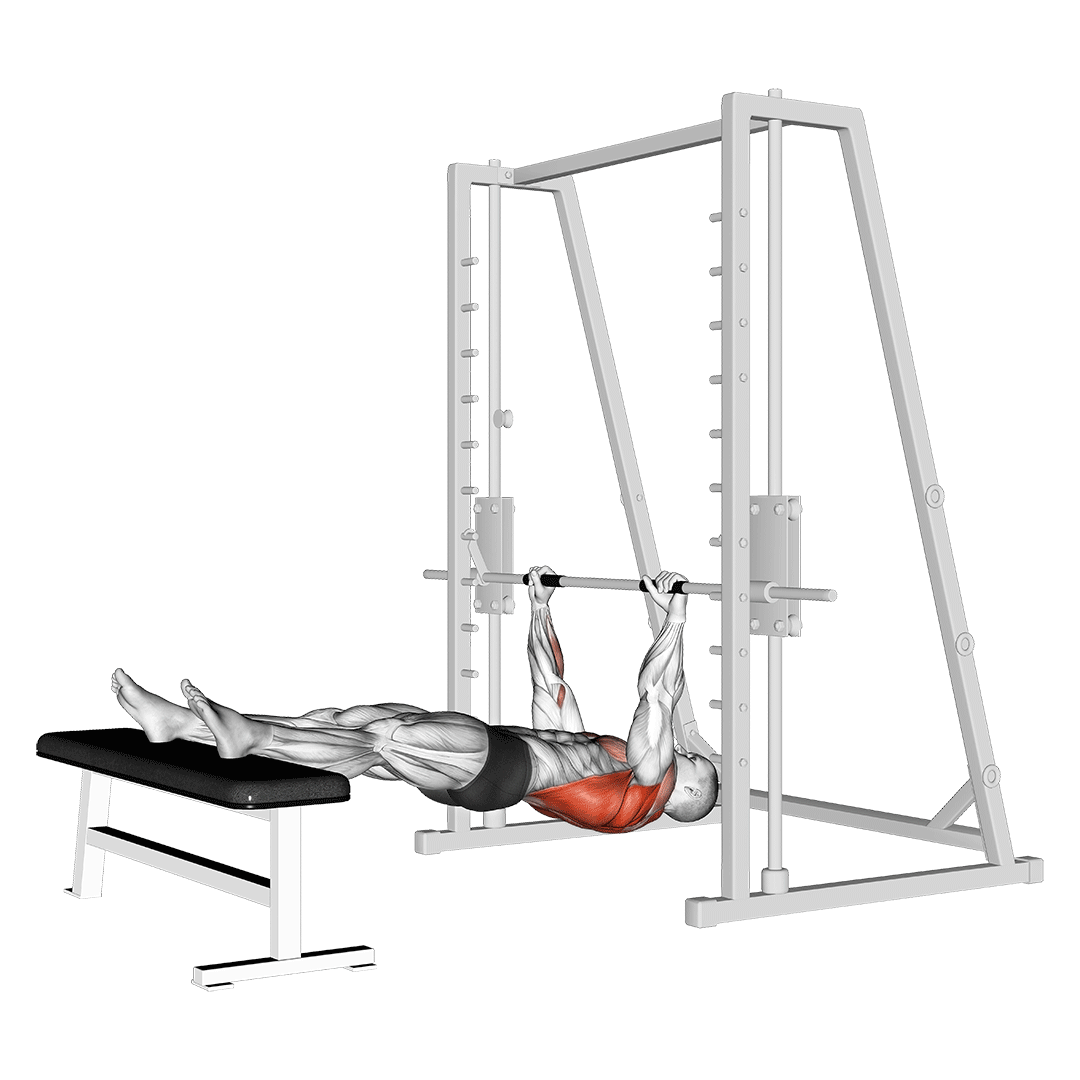
How to Do Feet Elevated Inverted Rows
Warm-up: Before commencing the exercise, warm up your muscles with light cardio and dynamic stretches to prevent injuries.
Positioning:
- Adjust the Pull-Up Bar Height: Set the pull-up bar at a height that allows your feet to rest comfortably on a stable surface, such as a box or platform.
- Foot Placement: Place your feet flat on the surface, ensuring your body forms an incline of approximately 30-45 degrees.
Grip and Execution:
- Grip the Pull-Up Bar: Grip the pull-up bar with a comfortable overhand grip, ensuring your palms are facing away from you.
- Engage Your Core: Activate your abdominal muscles to stabilize your body throughout the movement.
- Initiate the Row: Pull yourself up towards the bar until your chest reaches or nearly reaches the bar. Focus on engaging your back muscles, particularly the lats.
- Slow and Controlled Descent: Slowly lower yourself back down to the starting position while maintaining a straight body alignment. Avoid swinging or using momentum to assist the movement.
- Repeat: Aim for 3 sets of as many repetitions as you can maintain proper form.
Muscles Worked by Feet Elevated Inverted Rows
- Latissimus Dorsi (Lats): The large, fan-shaped muscles that run along the sides of your back are the primary muscle worked in feet elevated inverted rows due to the incline angle and greater range of motion.
- Biceps Brachii: Located in the front of the upper arms, the biceps assist in pulling yourself up by bending your elbows.
- Posterior Deltoids: The back shoulders are engaged in stabilizing the shoulder joint during the pulling motion.
- Forearms: The forearms are responsible for gripping the pull-up bar throughout the entire movement.
Lat Pulldowns
The lat pulldown is a compound exercise that targets the latissimus dorsi (lats), the large, fan-shaped muscles that run along the sides of the back. It also works the biceps brachii, the main muscles in the front of the upper arms, and other muscles in the back, shoulders, and forearms.
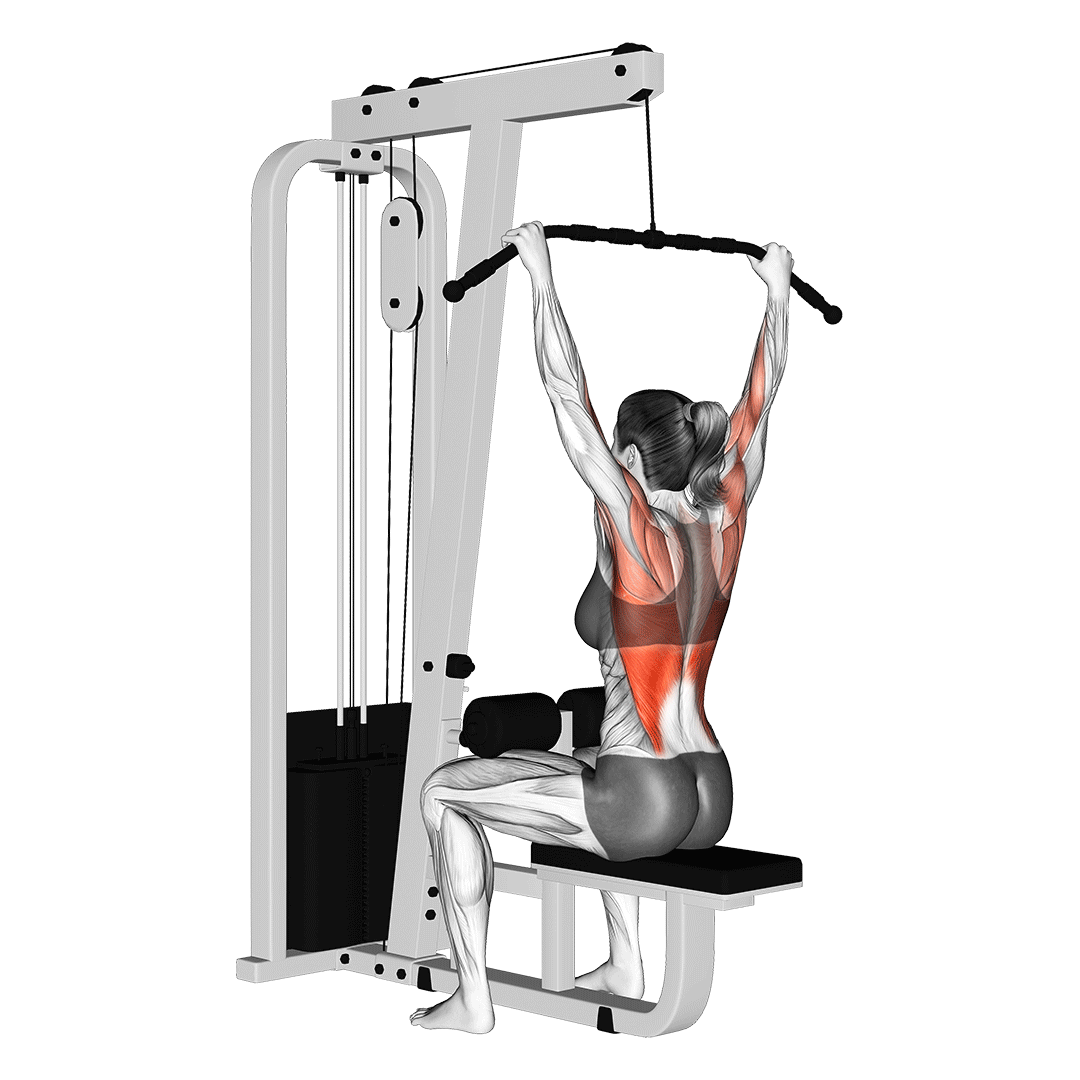
How to Do Lat Pulldowns
- Warm-up: Before commencing the exercise, warm up your muscles with light cardio and dynamic stretches to prevent injuries.
- Adjust the Weight: Choose a weight that is challenging but allows you to maintain proper form throughout the set.
- Grip the Lat Pulldown Machine: Grip the lat pulldown bar with a wide overhand grip, ensuring your palms are facing away from you.
- Engage Your Core: Activate your abdominal muscles to stabilize your body throughout the movement.
- Pull Down: Pull the bar down towards your chest until your elbows are bent at a 90-degree angle. Focus on engaging your lats and pulling from your elbows, not your arms.
- Controlled Descent: Slowly lower the bar back to the starting position.
- Repeat: Aim for 3 sets of 8-12 repetitions.
Muscles Worked by Lat Pulldowns
- Latissimus Dorsi (Lats): The primary muscle worked in lat pulldowns due to the wide grip and pulling motion.
- Biceps Brachii: Located in the front of the upper arms, the biceps assist in pulling the bar down by bending your elbows.
- Trapezius: The trapezius muscles in the upper back are engaged in stabilizing the shoulder joint during the movement.
- Rhomboids: The rhomboids are muscles situated between the shoulder blades, assisting in pulling the shoulder blades together.
- Forearms: The forearms are responsible for gripping the bar throughout the entire movement.
Underhand Grip Lat Pulldowns
The underhand grip lat pulldown is a compound exercise that targets the latissimus dorsi (lats), the large, fan-shaped muscles that run along the sides of the back. It also works the biceps brachii, the main muscles in the front of the upper arms, and other muscles in the back, shoulders, and forearms. The underhand grip focuses more on the biceps brachii, while the overhand grip targets the lats more.
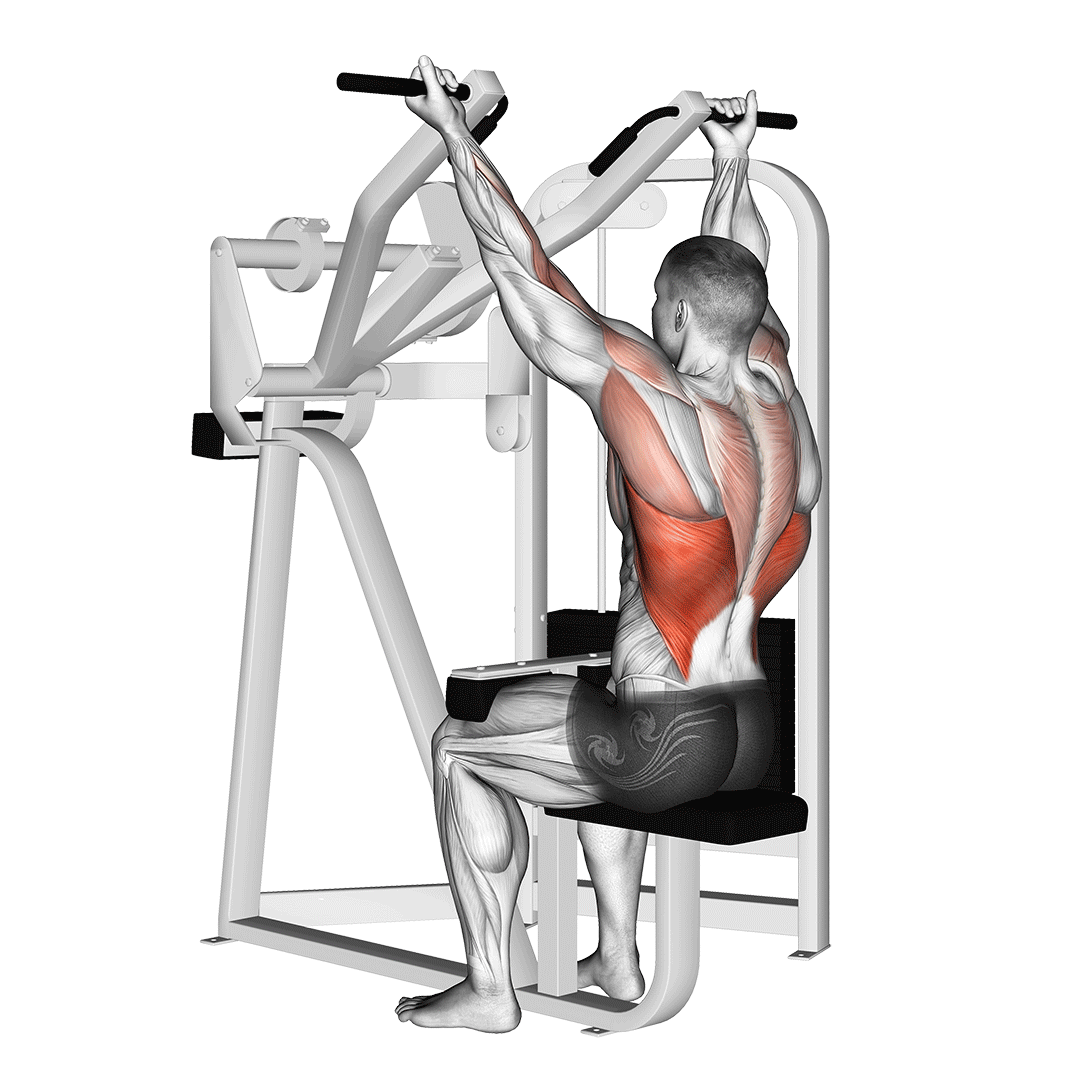
How to Do Underhand Grip Lat Pulldowns
- Warm-up: Before commencing the exercise, warm up your muscles with light cardio and dynamic stretches to prevent injuries.
- Adjust the Weight: Choose a weight that is challenging but allows you to maintain proper form throughout the set.
- Grip the Lat Pulldown Machine: Grip the lat pulldown bar with an underhand grip, ensuring your palms are facing towards you.
- Engage Your Core: Activate your abdominal muscles to stabilize your body throughout the movement.
- Pull Down: Pull the bar down towards your chest until your elbows are bent at a 90-degree angle. Focus on engaging your lats and pulling from your elbows, not your arms.
- Controlled Descent: Slowly lower the bar back to the starting position.
- Repeat: Aim for 3 sets of 8-12 repetitions.
Muscles Worked by Underhand Grip Lat Pulldowns
- Biceps Brachii: Located in the front of the upper arms, the biceps are the primary muscle worked in underhand grip lat pulldowns due to the underhand grip and pulling motion.
- Latissimus Dorsi (Lats): The lats are the secondary muscle worked, helping to stabilize the shoulder joint during the movement.
- Trapezius: The trapezius muscles in the upper back are engaged in stabilizing the shoulder joint during the movement.
- Rhomboids: The rhomboids are muscles situated between the shoulder blades, assisting in pulling the shoulder blades together.
- Forearms: The forearms are responsible for gripping the bar throughout the entire movement.
FAQs
What are pull-ups and why are they beneficial?
Pull-ups are a compound exercise that engages multiple muscle groups in your upper body, including your latissimus dorsi (lats), biceps brachii, trapezius, rhomboids, and forearms. They are an excellent way to build strength, muscle mass, and improve grip strength. Pull-ups can also help to improve your posture and coordination.
What are some benefits of pull-ups?
- Build strength and muscle mass in your upper body: Pull-ups are a great way to target all of the major muscle groups in your back, including your lats, biceps, trapezius, and rhomboids. They can also help to build muscle mass in your forearms.
- Improve grip strength: Pull-ups require you to grip the bar firmly throughout the entire exercise. This can help to improve your grip strength, which is important for many other activities, such as rock climbing, weightlifting, and everyday tasks.
- Improve posture and coordination: Pull-ups can help to improve your posture by strengthening the muscles that support your back. They can also help to improve your coordination by requiring you to control your body’s movement throughout the exercise.
- Burn calories and improve cardiovascular health: Pull-ups are a calorie-burning exercise that can help to improve your cardiovascular health. They can also help to improve your overall fitness and endurance.
How can I start doing pull-ups if I can’t do any yet?
If you can’t do any pull-ups yet, there are a few things you can do to start working towards your goal:
- Use a pull-up assist machine: Pull-up assist machines allow you to use your bodyweight plus some additional weight to complete a pull-up. This can make it easier to lift yourself up until you are strong enough to do one on your own.
- Use resistance bands: Resistance bands provide resistance as you pull yourself up, making it easier to complete a pull-up. You can start with a light band and gradually increase the resistance as you get stronger.
- Start with negatives: Negative pull-ups involve lowering yourself down from the bar slowly and controlled. This is a great way to build strength and endurance in your back muscles.
- Practice hanging from the bar: Hanging from the bar for as long as you can can help to improve your grip strength and upper body strength.
What are some tips for improving my pull-up form?
Here are a few tips for improving your pull-up form:
- Grip the bar with a wide overhand grip: A wide grip will help to target your lats more effectively.
- Engage your core and keep your back straight: This will help to protect your spine and ensure that you are using your muscles correctly.
- Pull yourself up until your chin is over the bar: Don’t try to pull yourself up all the way to your chest.
- Slow down the eccentric (lowering) phase of the movement: This will help to build strength and muscle endurance.
- Take some breaks if you need to: Don’t try to do too many pull-ups at once. Take breaks as needed to catch your breath.
How long should I rest between sets of pull-ups?
Aim for 30-60 seconds of rest between sets. This allows your muscles to recover enough to perform the next set effectively.
What are some tips for improving my pull-up strength?
Focus on compound exercises that target the back muscles, such as rows and deadlifts. Practice pull-ups consistently, gradually increasing the number of repetitions and sets. Use resistance bands for assistance if needed.
What are some common pull-up mistakes to avoid?
Avoid using momentum to lift yourself up. Instead, focus on controlled movements using your back muscles. Don’t arch your back excessively, as this can put strain on your spine. Maintain proper grip width and hand placement.

